Basic passport checks (accessible)
Updated 1 December 2025
Applies to England and Wales
Cases of document fraud involving the UK passport should be reported to HM Passport Office.
This includes altered or counterfeited UK passports and instances in which it is suspected that a person might not be entitled to the UK passport that they have presented.
Please forward the details via email to: MISC.referral@hmpo.gov.uk giving your contact information.
Passports introduced in 1988
New UK passport designs are introduced through a phased roll-out. Older style passports were issued after the introduction of this design. These will continue to be valid until their stated expiry date.
Key Information
Validity
-
Adults, a maximum of 10 years.
-
Children, a maximum of 5 years
Size
- Approximately 125 x 88 mm
Number of pages
-
Standard issue book is 32 pages.
-
Business book is 48 pages
Location of the data page
- Page 32
Laminate
- Rear endpaper, sewn in, clear laminate with printing.
Photograph
- Conventional photograph, attached by adhesive patch
Numbering
- 9 digits, printed on page 1. These are entered on the rear endpaper in the same style as the personal details.
Observations
- On later versions of this passport European Community was changed to European Union and the name of the authority on the rear endpaper was changed from ‘Issuing Office xxx’ to ‘United Kingdom Passport Agency’ for those issued in the UK.
Extra Checks
-
The stitching thread is white and should not fluoresce in UV light.
-
The front endpaper is printed in burgundy intaglio (raised printing).
Note:
-
Passports issued overseas may not be machine readable (they will not have numbers/chevrons etc printed on the biodata page
-
Different versions of this passport exist (e.g. Jersey, Isle of Man, Gibraltar, British Virgin Islands and other UK territories).
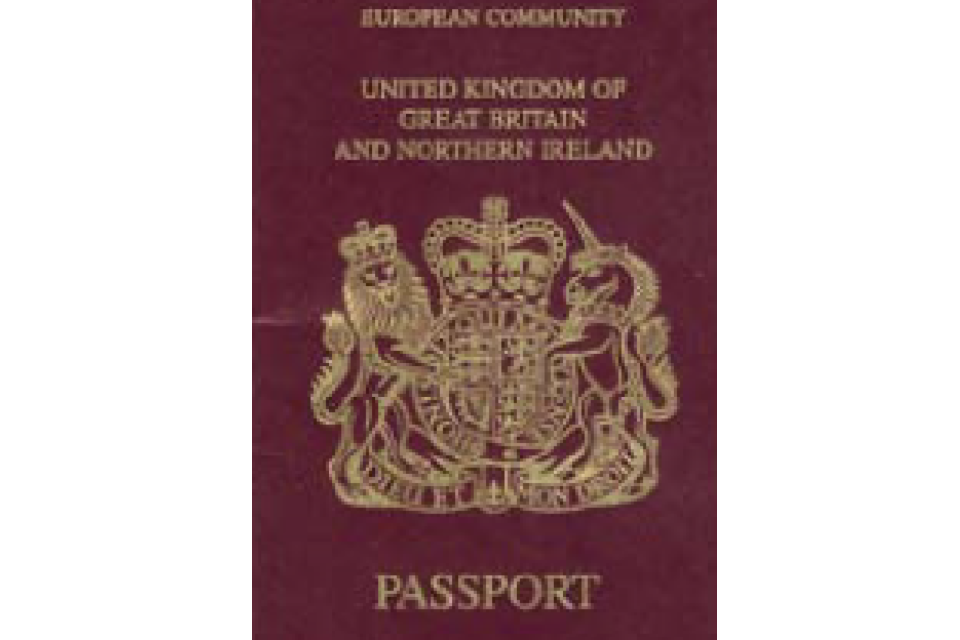
Passport cover
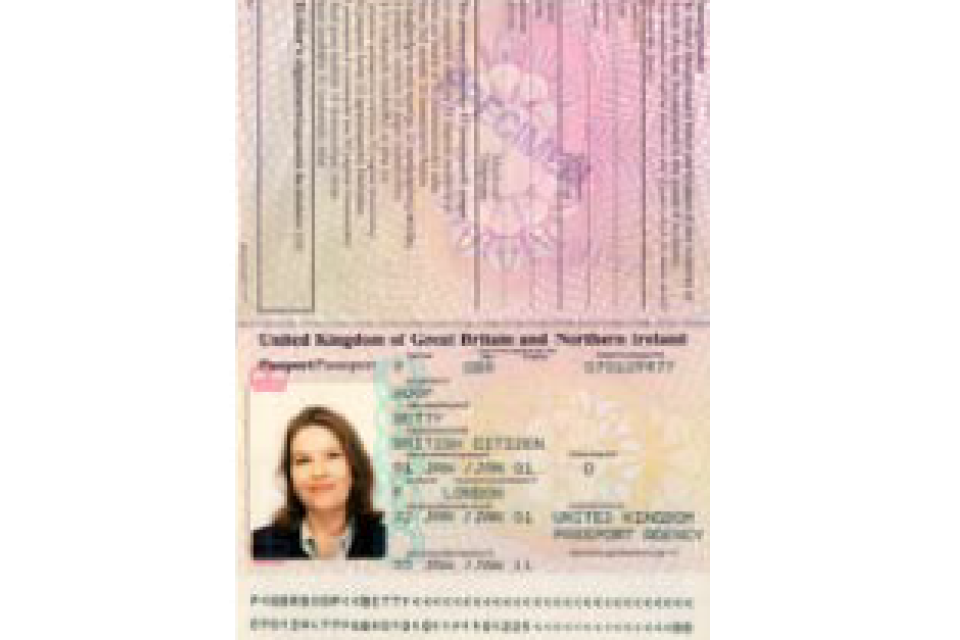
Biodata page in normal light
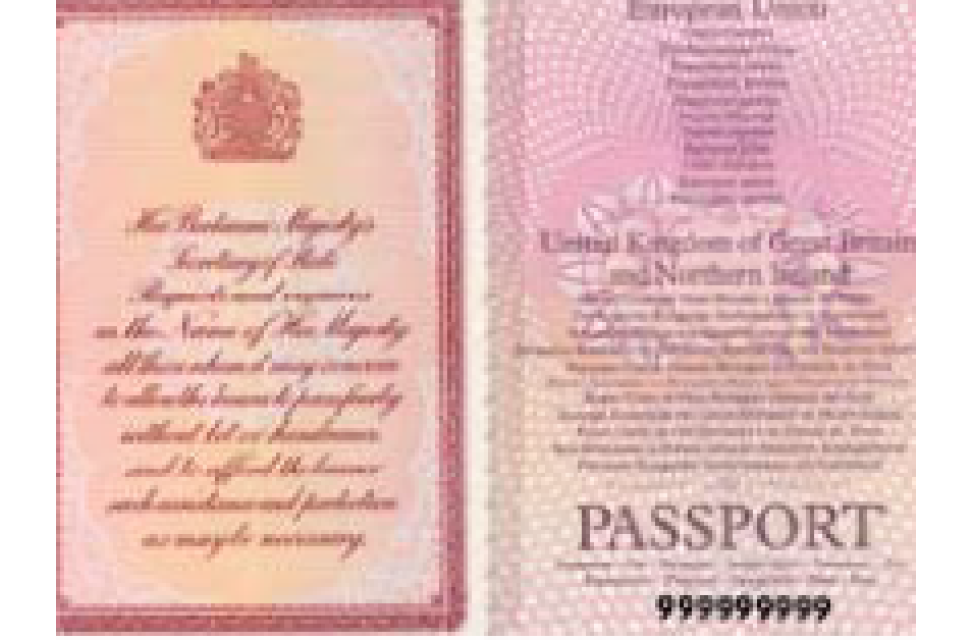
Front endpaper and page 1 in normal light

UV reaction of front endpaper and page 1
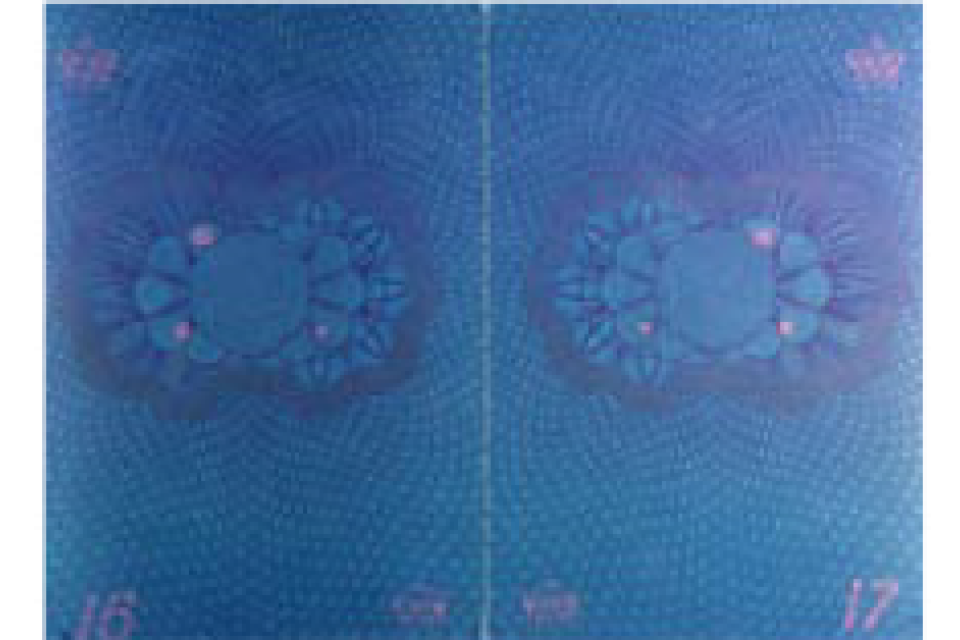
UV reaction of centre pages

Watermark
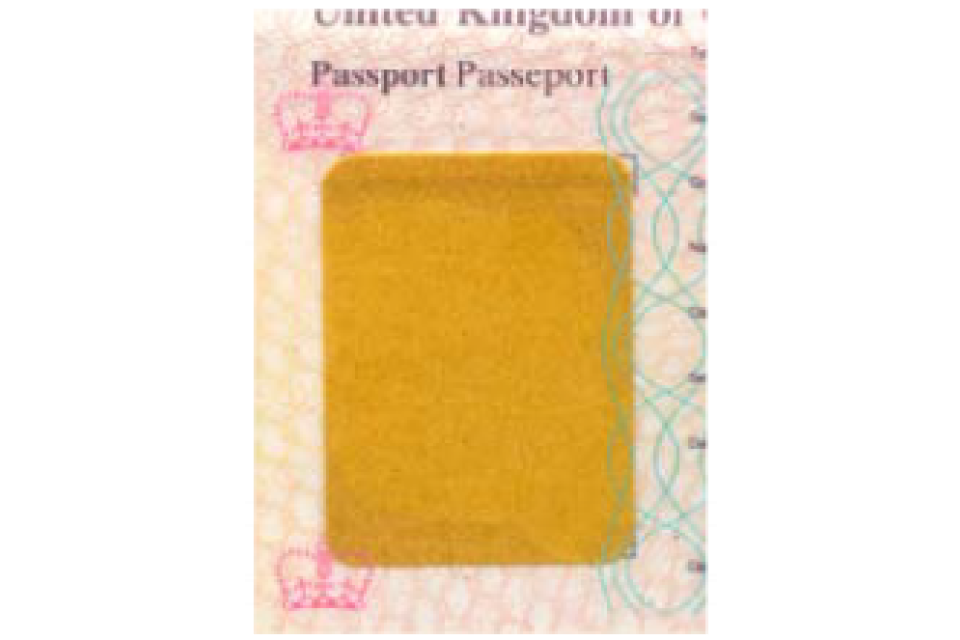
Printing on the laminate

UV reaction of biodata page
Passports introduced in 1998
New UK passport designs are introduced through a phased roll-out. Older style passports were issued after the introduction of this design. These will continue to be valid until their stated expiry date.
Key information
Validity
-
Adults, normally 10 years up to a maximum of 10 years 9 months.
-
Children, normally 5 years up to a maximum of 5 years 9 months.
Size
- Approximately 125 x 88 mm.
Number of pages
-
Standard issue book is 32 pages.
-
Business book is 48 pages.
Location of the data page
- Page 31.
Laminate
- Page 31 (or 47), sewn in, clear laminate with hologram on a patch.
Photograph
- Digitally printed.
Numbering
- 9 digits, printed on page 1. These are entered on the bio data page in the same style as the personal details.
Observations
- A UV visible daffodil motif can be seen on some visa pages, but not all. The destriperf (laser perforation) creates a patterned hole through the page.
Extra Checks
-
The holograms are on a photo-sized patch attached to the underside of the laminate.
-
The stitching thread is white and should fluoresce yellow in UV light.
-
The front and rear endpapers are printed in green and blue intaglio (raised printing).
Note
- Different versions of this passport exist (e.g. Jersey, Isle of Man, Gibraltar, British Virgin Islands and other UK territories).
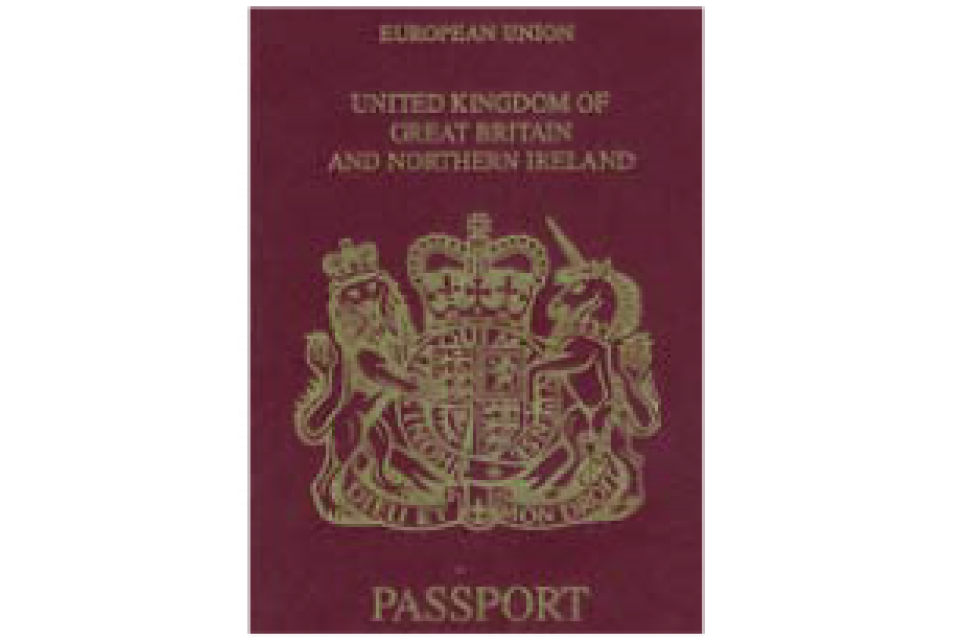
Passport cover
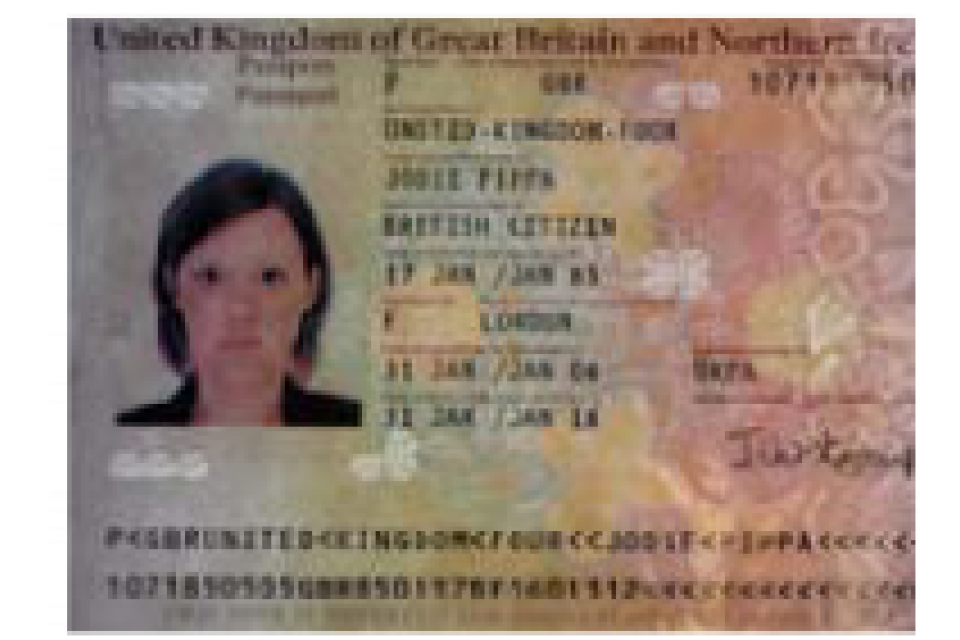
Biodata page showing destriperf
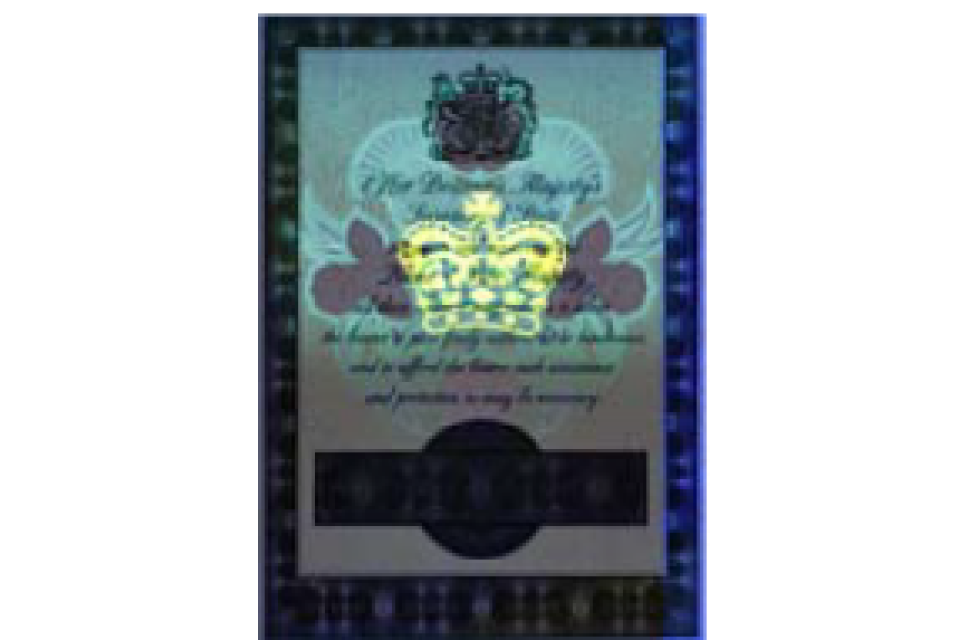
UV reaction of front endpaper
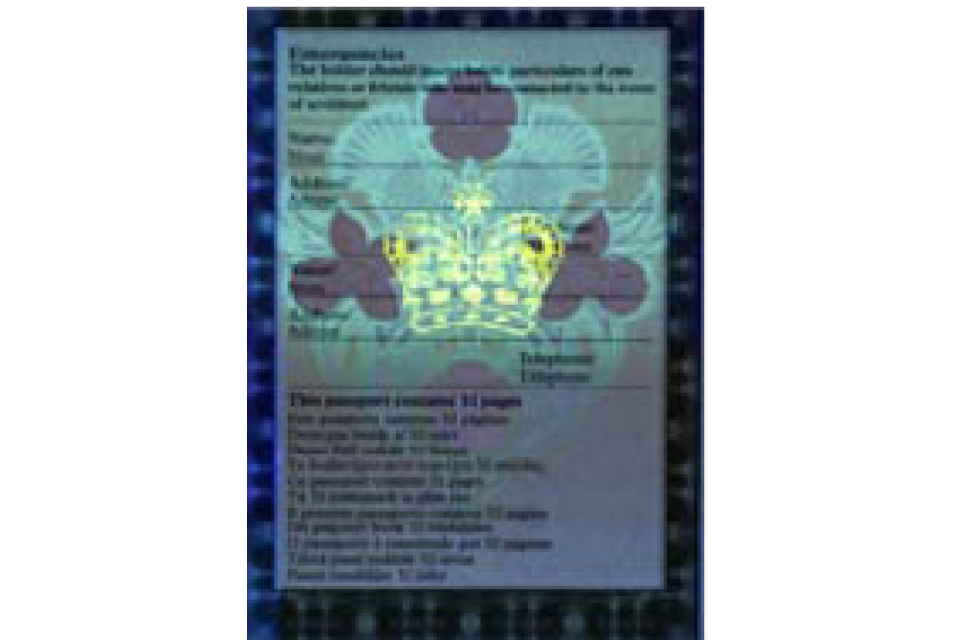
UV reaction of rear endpaper
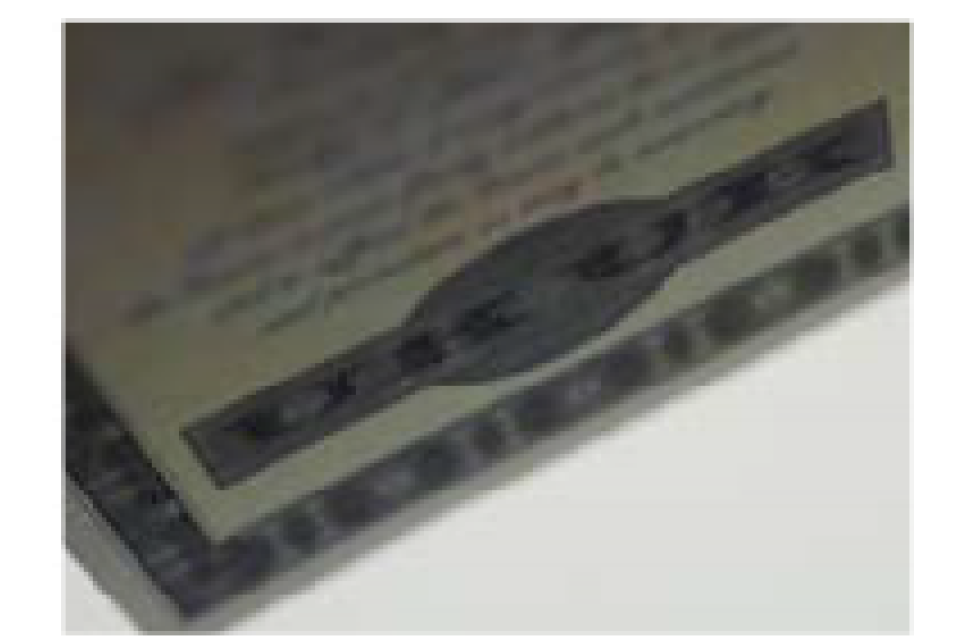
Latent image

Watermark pages 1-2 and 31-32
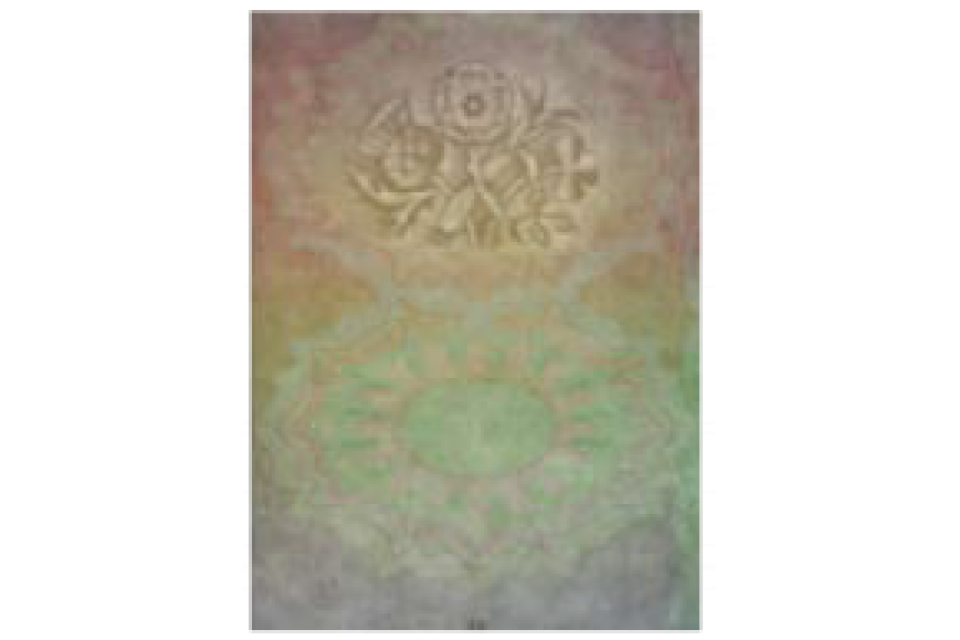
Watermark visa pages

UV reaction of some visa pages
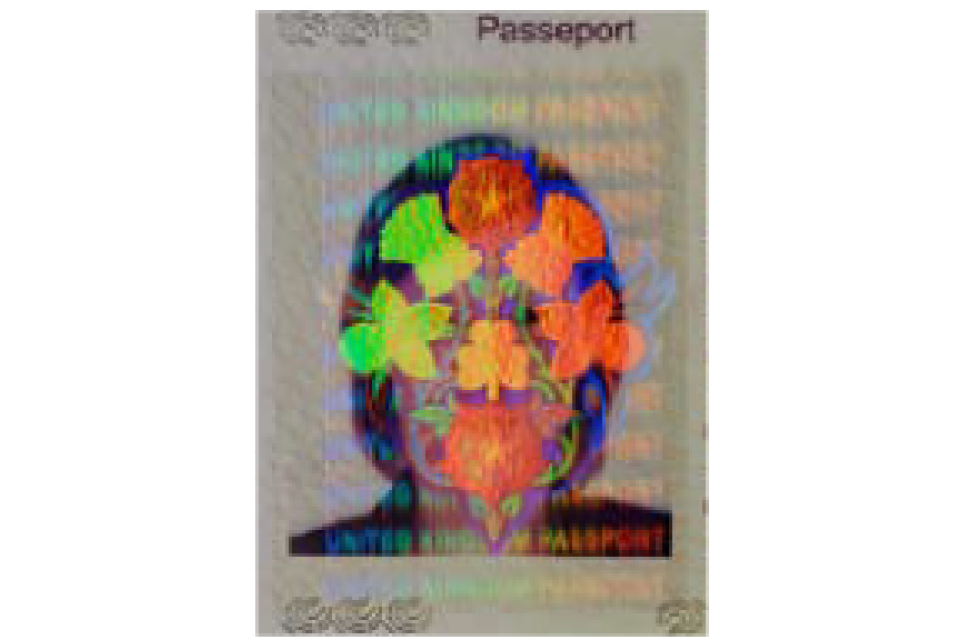
Hologram patch

Hologram views
Passports introduced in 2006
New UK passport designs are introduced through a phased roll-out. Older style passports were issued after the introduction of this design. These will continue to be valid until their stated expiry date.
Key information
Validity
-
Adults, normally 10 years up to a maximum of 10 years 9 months.
-
Children, normally 5 years up to a maximum of 5 years 9 months.
From 10 September 2018 all Adult passports will be issued with a duration of 10 years and will expire 10 years after the date of issue and all Child passports will be issued with a duration of 5 years and will expire 5 years after the date of issue
Size
- Approximately 125x88 mm.
Number of pages
-
Standard issue book is 32 pages.
-
Business book is 48 pages.
Location of the data page
- Page 31
Laminate
- Page 31 and 32, sewn in, clear laminate with UV visible printing and holograms on page 31.
Photography
- Digitally printed.
Numbering
- 9 digits, printed on page 1. These are entered on the bio data page in the same style as the personal details. The serial number is perforated through pages 1-30 (1-46 in business book).
Observations
- An electronic chip and antenna is visible on page 32 (48).
Extra Checks
-
The holograms are on three patches attached to the underside of the laminate on page 31.
-
The stitching thread is red, white and blue and fluoresces yellow and red in UV light.
-
The front and rear endpapers are printed in green, burgundy and blue intaglio (raised printing).
Note
-
The laminate on page 32 fluoresces strongly.
-
Different versions of this passport exist (e.g. Jersey, Guernsey, Isle of Man, Gibraltar).
-
The holes of the laser perforated number are larger at the front of the book and reduce in size to the back.

Passport cover
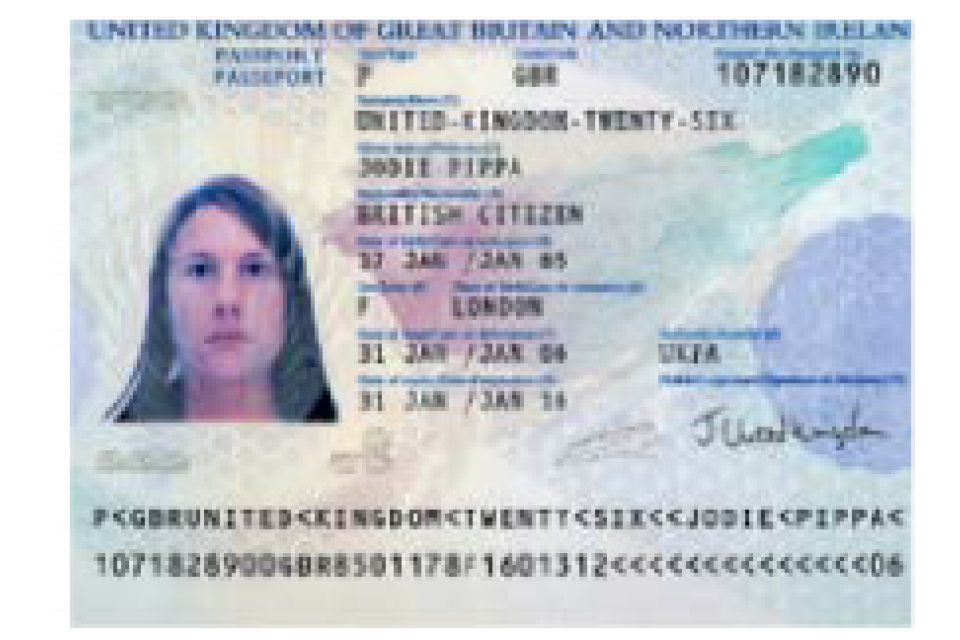
Biodata page in normal light
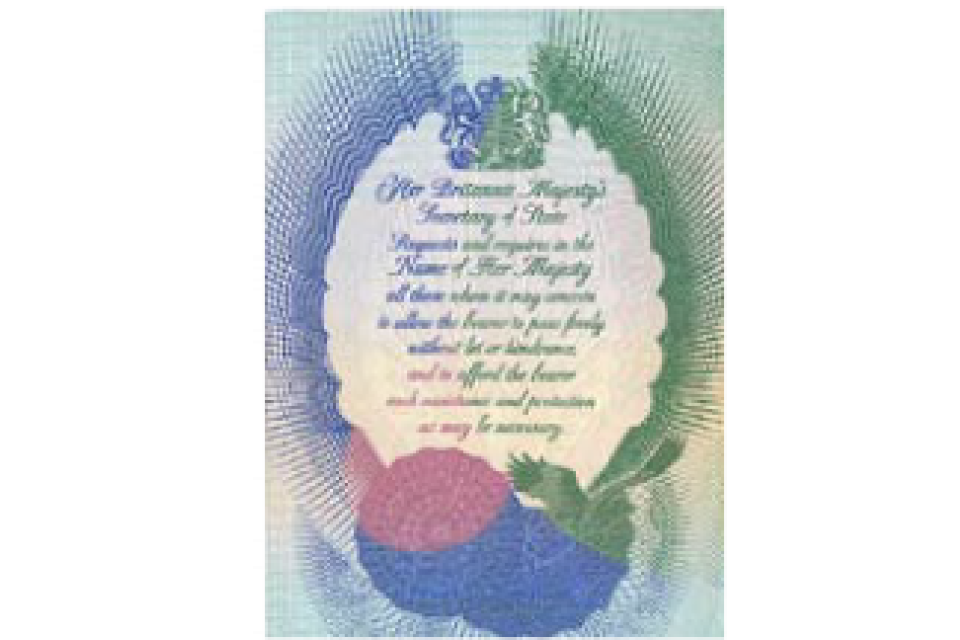
Front endpaper in normal light
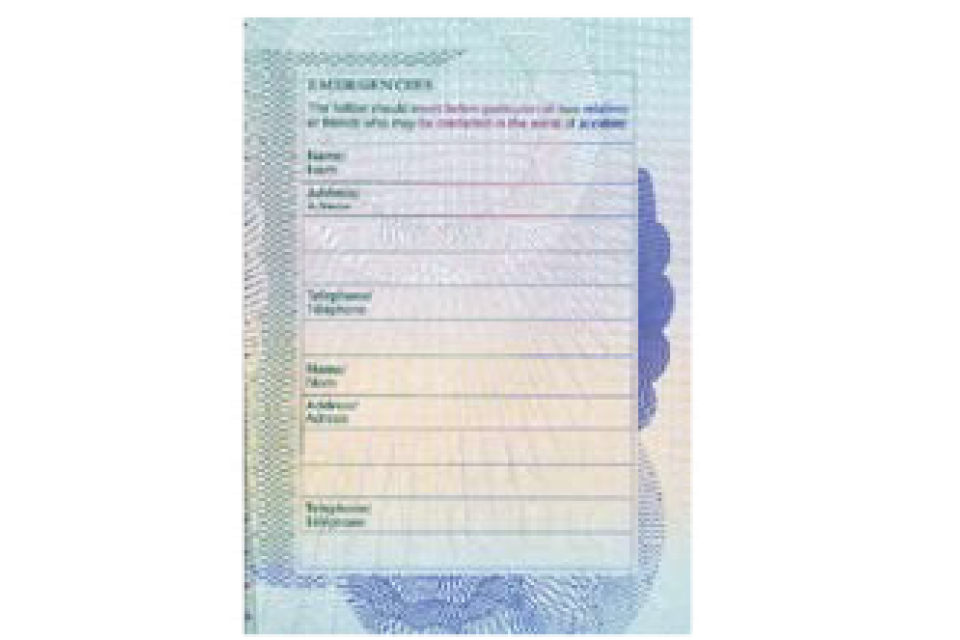
Rear endpaper in normal light

UV reaction of endpapers
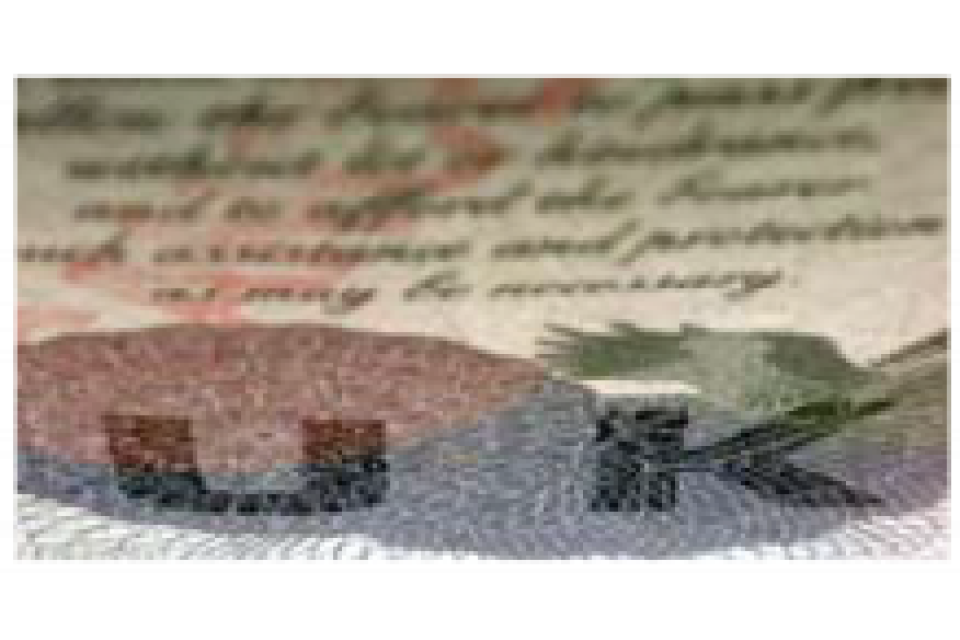
Latent image
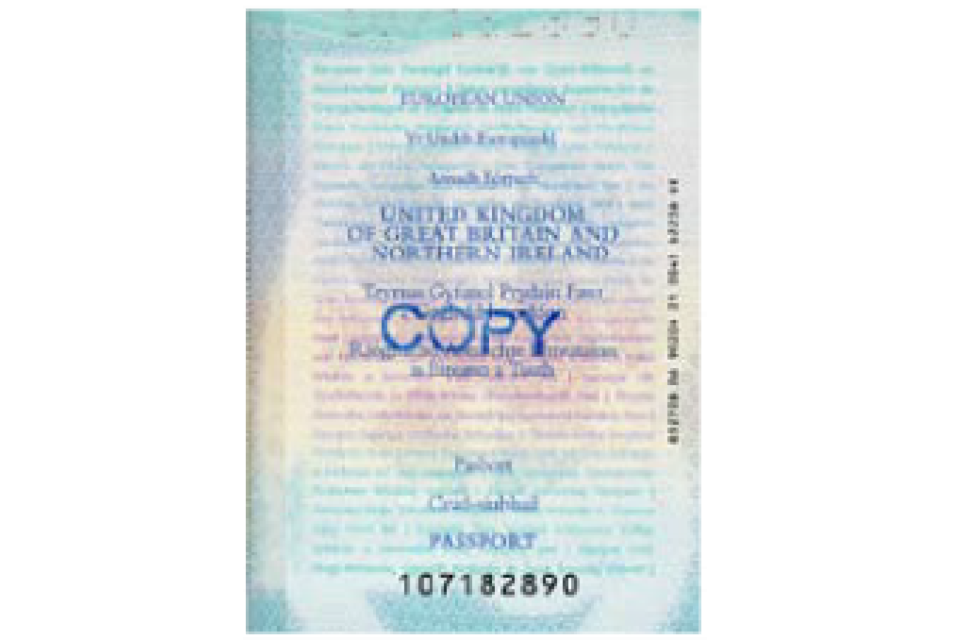
Page 1 in normal light

Watermark on biodata page
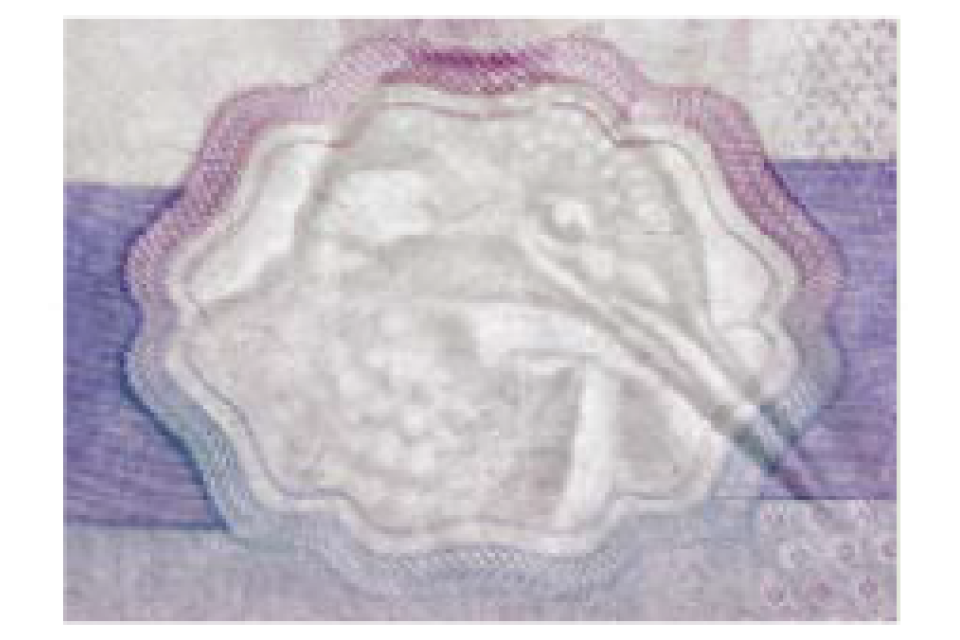
Watermark visa pages
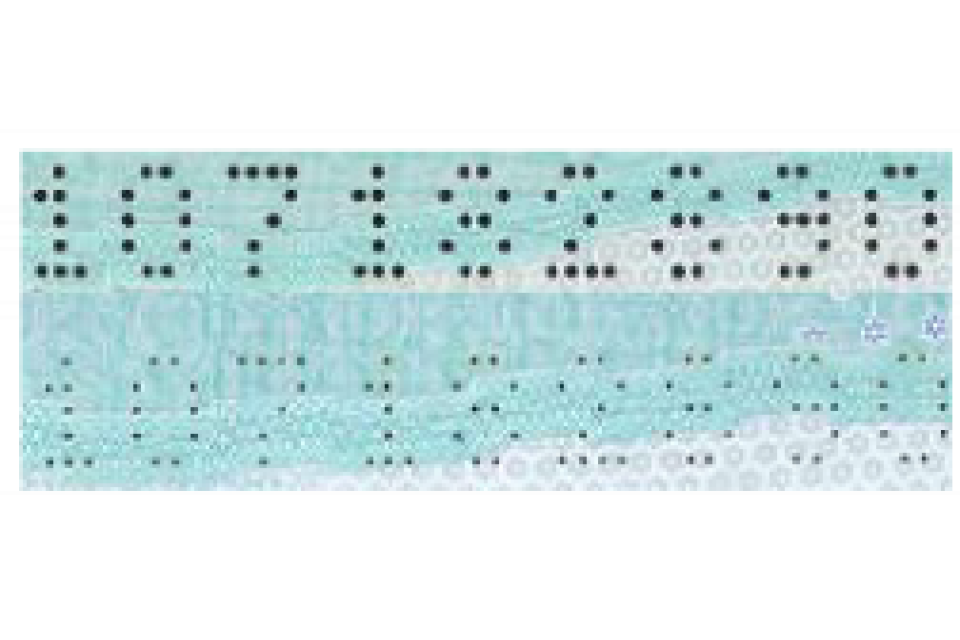
Laser perforated number

UV reaction of visa pages
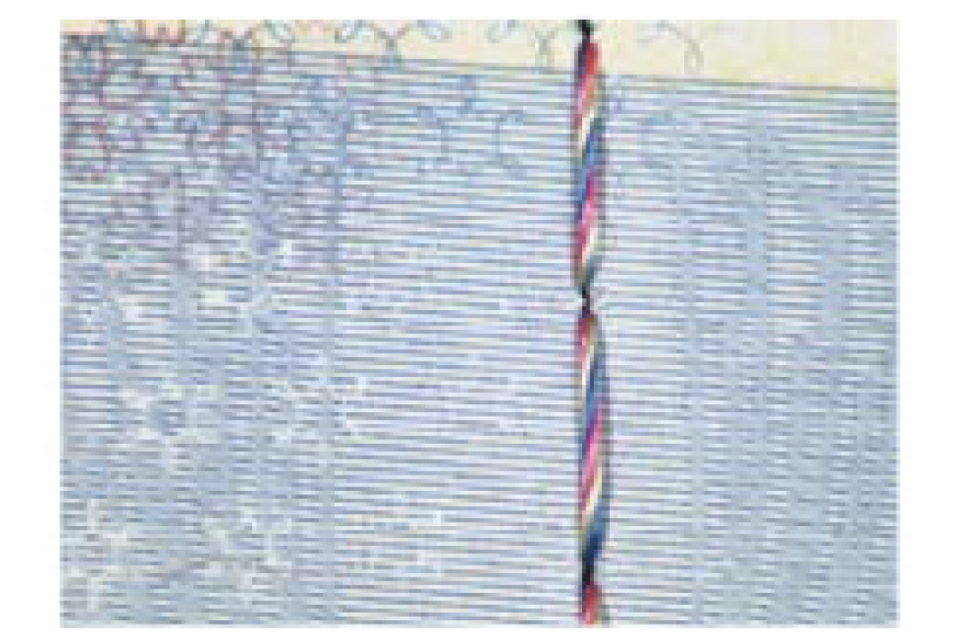
Stitching thread
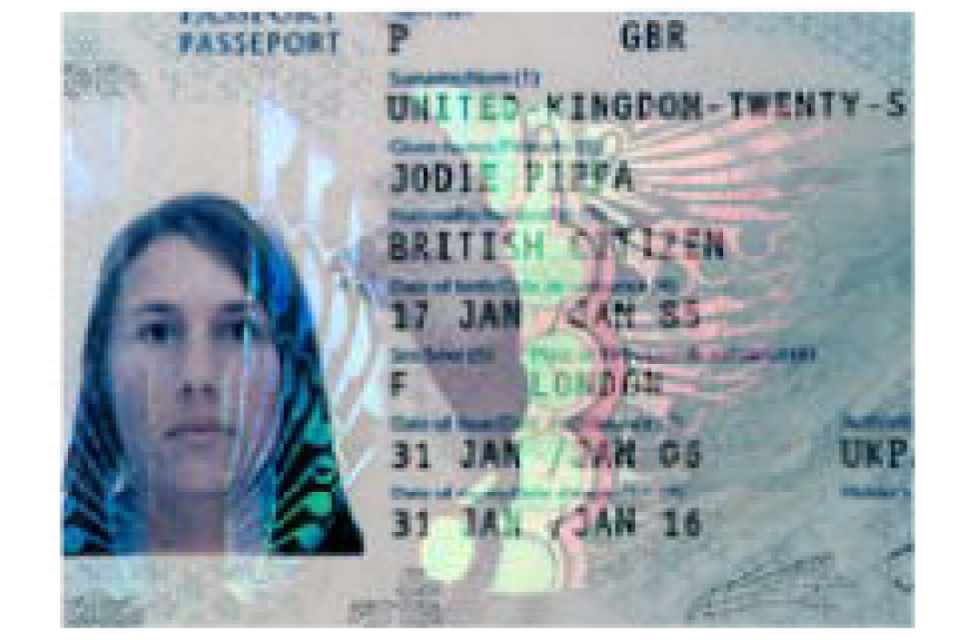
Hologram patches
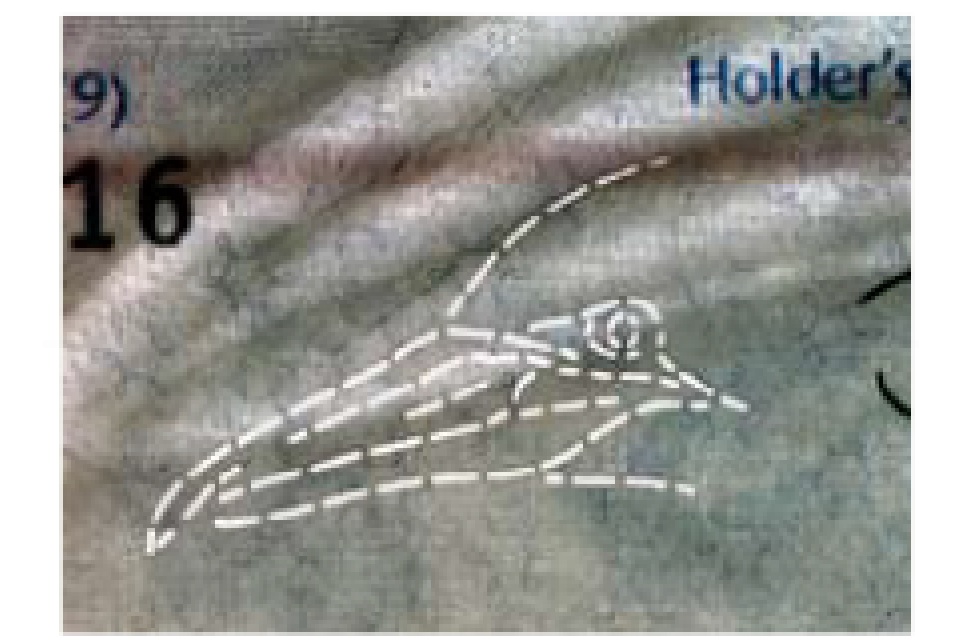
Destriperf (laser perforated pattern)

Biodata in UV light
Passports introduced in 2010
New UK passport designs are introduced through a phased roll-out. Older style passports were issued after the introduction of this design, these passports will continue to be valid until their stated expiry date.
Key information
Validity
-
Adults, normally 10 years up to a maximum of 10 years 9 months.
-
Children, normally 5 years up to a maximum of 5 years 9 months.
From 10 September 2018 all Adult passports will be issued with a duration of 10 years and will expire 10 years after the date of issue and all Child passports will be issued with a duration of 5 years and will expire 5 years after the date of issue
Size
- Approximately 125x88 mm.
Number of pages
- Standard issue book is 32 pages. Business book is 48 pages.
Location of the bio data page
- Page 2
Laminate
- Page 2 contains a thin film patch that is clear in colour but has UV visible printing and holograms contained within it. Page 3 is not laminated.
Photograph
- Digitally printed on pages 2 and 3
Numbering
-
9 digits, printed on page 1. These are entered on the bio data page (page 2) in the same style as the personal details.
-
The serial number is perforated from page 1 through to the rear cover of the passport.
-
The thin film patch contains a unique serial number which consists of 3 alpha characters and 4 numeric followed by a check symbol. This number is located beneath the holder’s image should not be confused with the 9 digit passport number.
Observations
-
Passport visa pages feature a cross-page security printed design.
-
A secondary image of the passport holder is located on page ‘3’ of the passport.
-
Additional information about the passport holder is written on page ‘3’ of the passport.
-
A check symbol is included within the laser perforated passport number. This symbol is not replicated within the printed serial number of the book on pages 1 and 2 and differs to the check symbol that is present for each thin film patch.
-
Observation data is bounded above and below by lines consisting of a unique character. The passport stitching method utilises a process that is different to any previous UK passport.
-
The gold foil on the front cover is more lustrous than that of the previous UK passport.
-
Where the passport holder does not require any additional data to be inserted into the passport, the passport observations page (page 3) will read “THERE ARE NO OFFICIAL OBSERVATIONS”
Laminate
- Page 2 contains a thin film patch that is clear in colour but has UV visible printing and holograms contained within it. Page 3 is not laminated.
Note
-
The bio data (personal details) page is at the front of the passport and located on page 2.
-
The passport chip is located in the cover of the passport.
-
The invisible printing of the laminate fluoresces strongly.
-
The laser perforated number consists of variable hole shapes (circle, square and triangle).

Passport cover
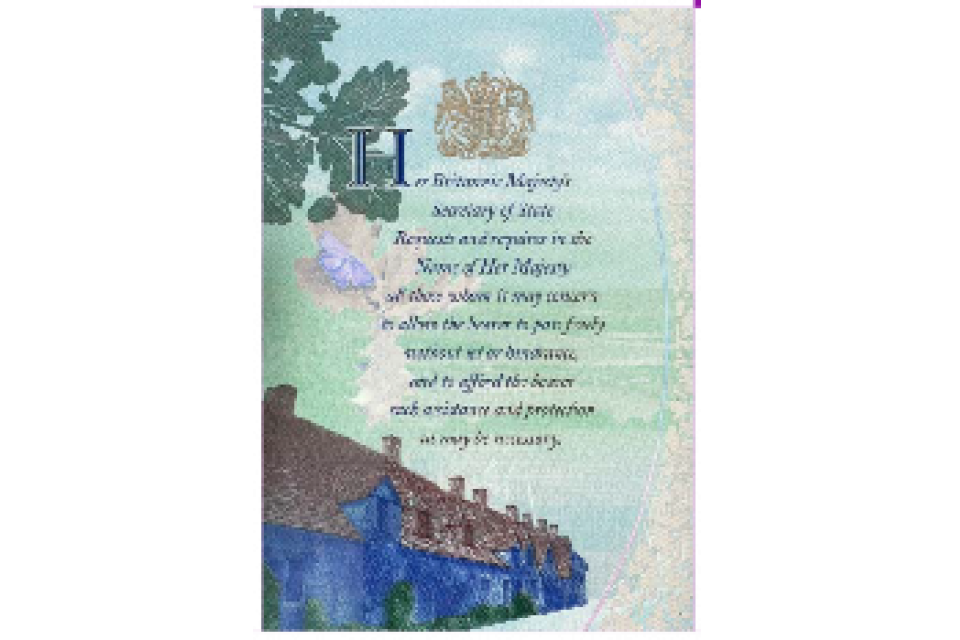
Front endpaper (normal light)
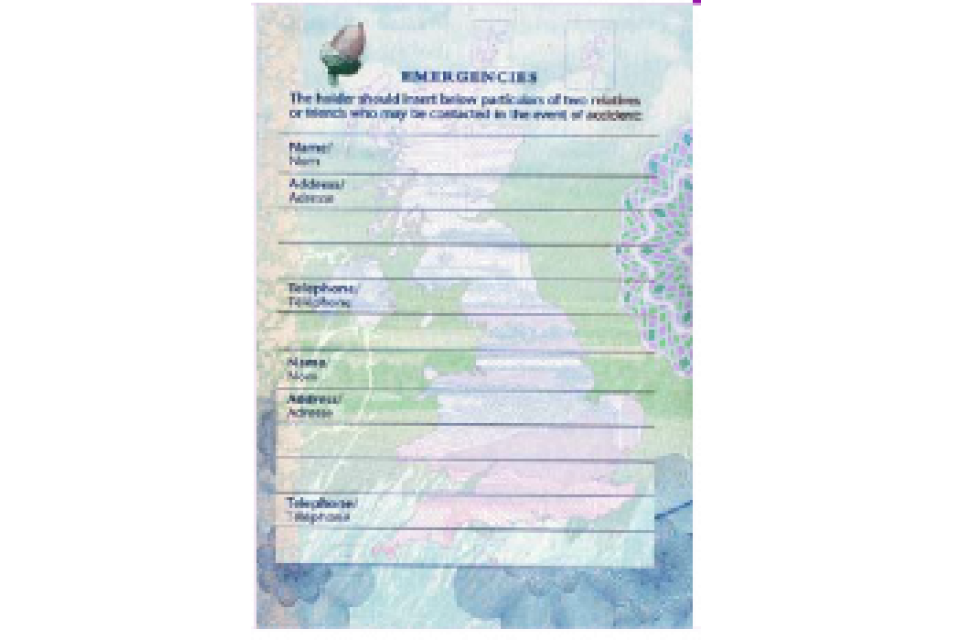
Rear endpaper (normal ligtht)
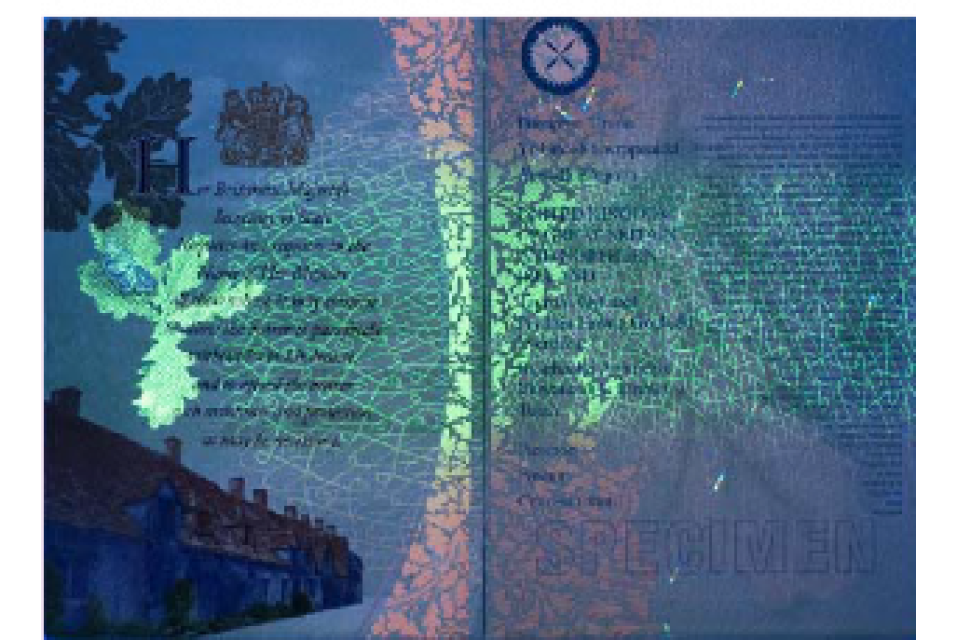
Front endpaper (UV light)

Biodata and Observation page (normal light)
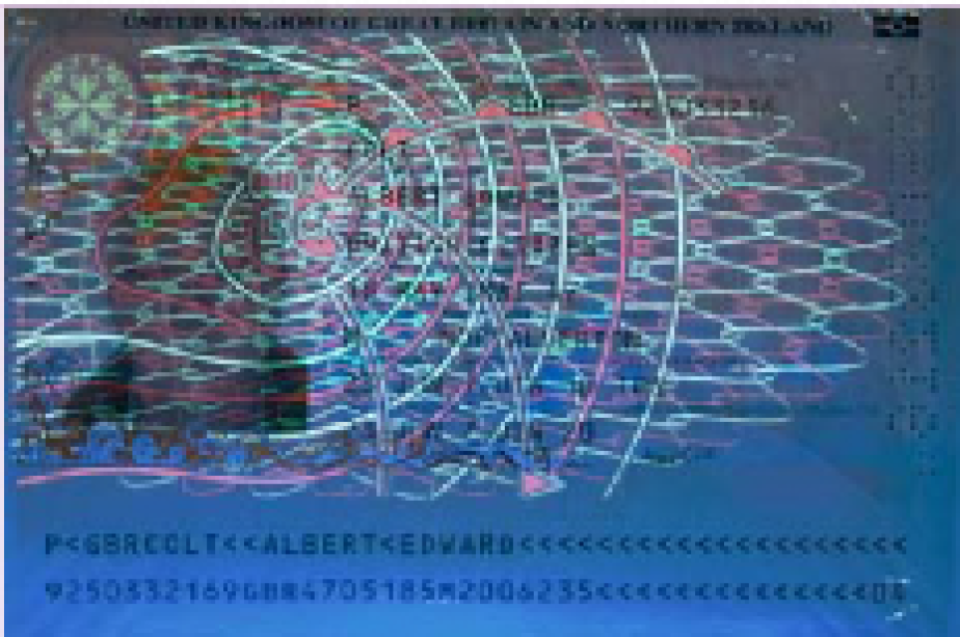
Biodata page (UV light)
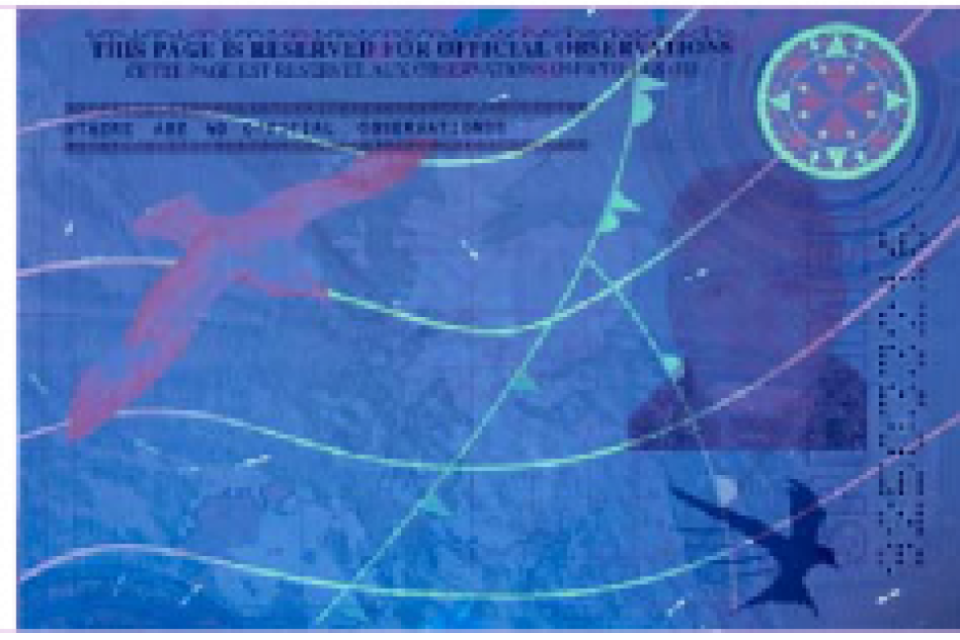
Observation page (UV light)

Visa page, cross-page design (normal light)

Visa page, cross-page design (UV light)

Biodata page (watermark)

Visa page (watermark)

See-through feature (Page 1/Biodata page)
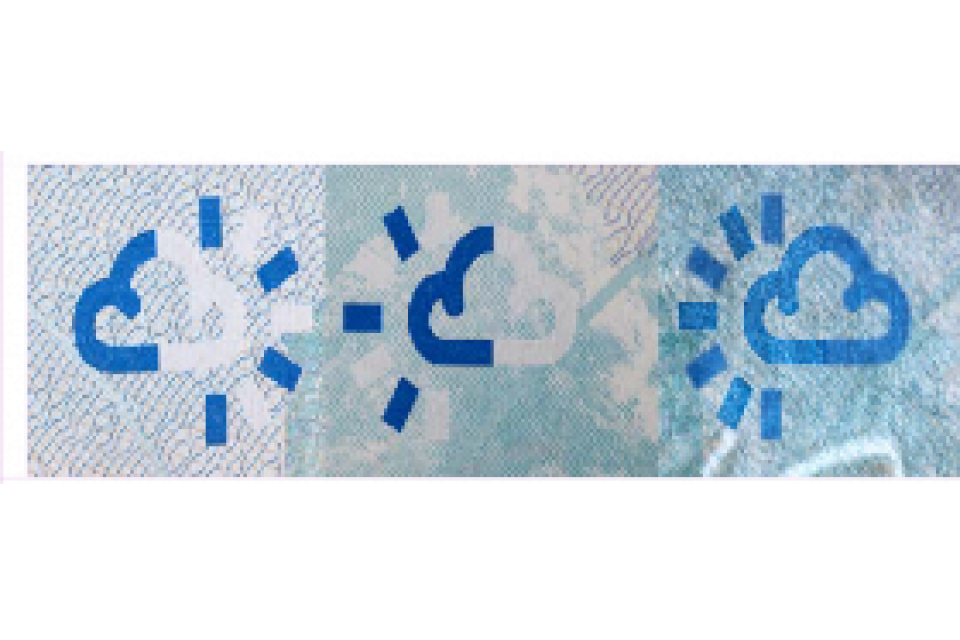
See-through feature (Visa pages)

Holographic elements of thin film patch
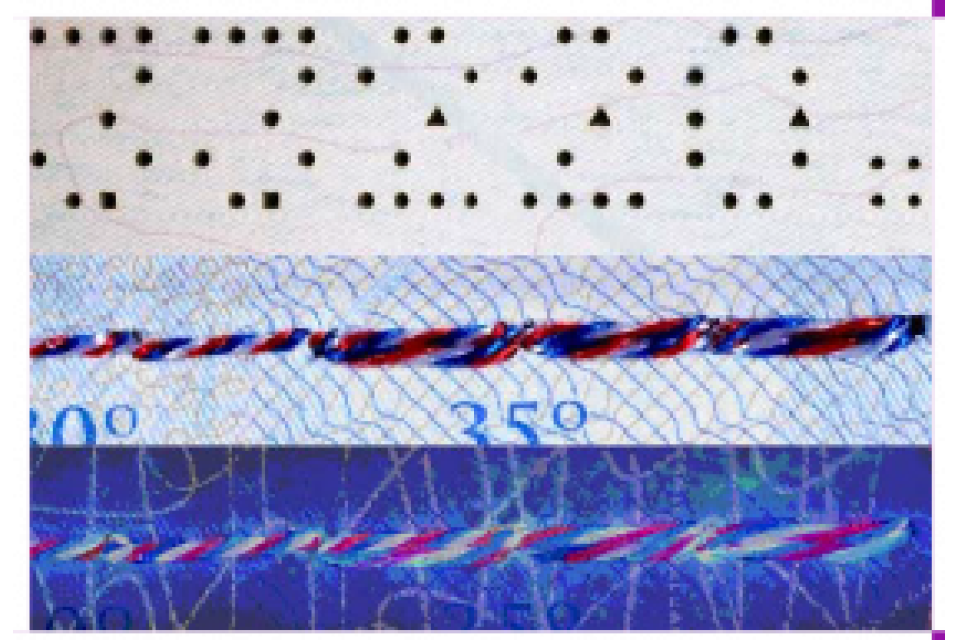
Variable hole shaped laser perforated numbering/ Stitching thread (normal light)/Stitching thread (UV light) respectively
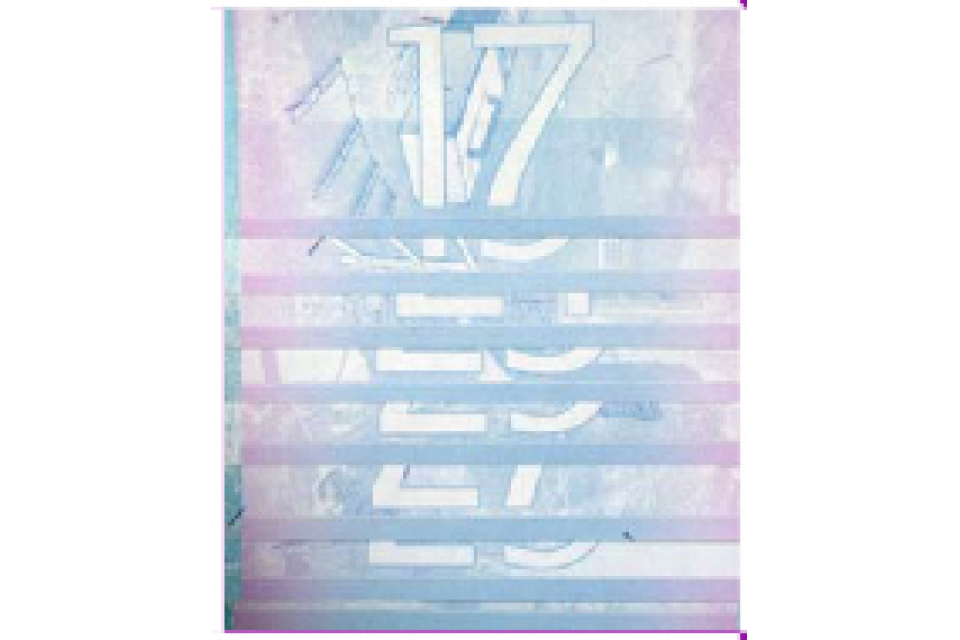
Raincheck feature

Candy stripe fibres (normal and UV light respectively)

Latent image of 'UK' (front endpaper)
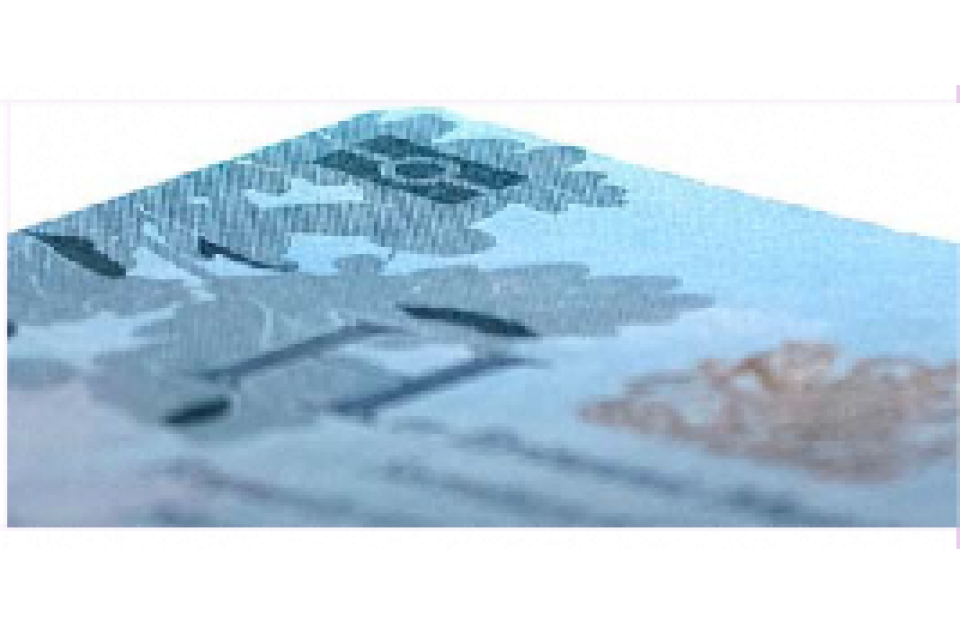
Latent image of 'ICAO' logo (front endpaper)
Passports introduced in 2015-2016
The new UK series B e-Passport will be introduced through a phased implementation from December 2015. During this transition period some customers will receive the series B e-Passport, whilst others will receive the UK e-Passport that was introduced in 2010. All issued UK passports will continue to be valid until their stated date of expiry.
Key information
Validity
-
Adults, normally 10 years up to a maximum of 10 years 9 months.
-
Children, normally 5 years up to a maximum of 5 years 9 months.
From 10 September 2018 all Adult passports will be issued with a duration of 10 years and will expire 10 years after the date of issue and all Child passports will be issued with a duration of 5 years and will expire 5 years after the date of issue
Size
- Approximately 125x88 mm.
Number of pages
-
Standard issue book is 34 pages.
-
Jumbo book is 50 pages.
Laminate
- Page 2 contains a thin film patch that is clear in colour but has UV visible printing and holograms contained within it. Page 3, the Official Observations page is not laminated.
Photograph
-
Digitally printed on pages 2 and 3.
-
Digitally embedded into the electronic chip.
Numbering
-
9 digits, printed on page 1. These are entered on the biodata page (page 2) in the same style as the personal details.
-
The serial number is perforated from page 1 of the passport through to the rear cover.
-
The thin film patch contains a unique serial number which consists of 3 alpha characters and 4 numeric followed by a check symbol. This number is located beneath the holder’s image and should not be confused with the 9 digit passport number.
Observations
-
Passport visa pages feature a cross-page security printed design.
-
A secondary image of the passport holder is located on page ‘3’ of the passport.
-
Additional information about the passport holder is written on page ‘3’ of the passport.
-
A check symbol is included within the laser perforated passport number. This symbol is not replicated within the printed serial number of the book on pages 1 and 2 and differs to the check symbol that is present for each thin film patch.
-
Observation data is bounded above and below by lines consisting of a unique character.
-
Where the passport holder does not require any additional data to be inserted into the passport, a note stating “THERE ARE NO OFFICIAL OBSERVATIONS” will be printed on the page 3 of the passport, the Official Observations page
Note
-
The biodata (personal details) page forms one continuous sheet with the rear end page.
-
The biodata page is at the front of the passport and located on page 2.
-
A high level security feature information page can be found on page 5 of the passport.
-
nbsp; The passport chip is located in the cover of the passport.
-
The invisible printing of the laminate fluoresces strongly.
-
The laser perforated number consists of variable shapes (circle, square and triangle).
-
Passport observations are bounded above and below by a line consisting of a unique character. The line below the last printed observation denotes that no further observations can be included within the passport. Additionally, the first and last character of each line will be the unique character.

Passport cover
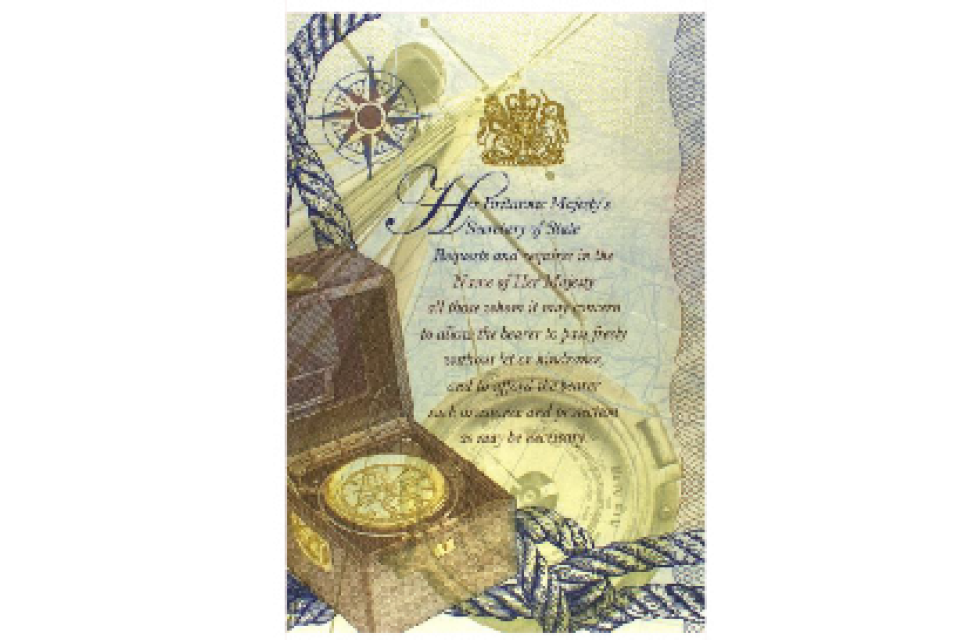
Front end page (normal light)
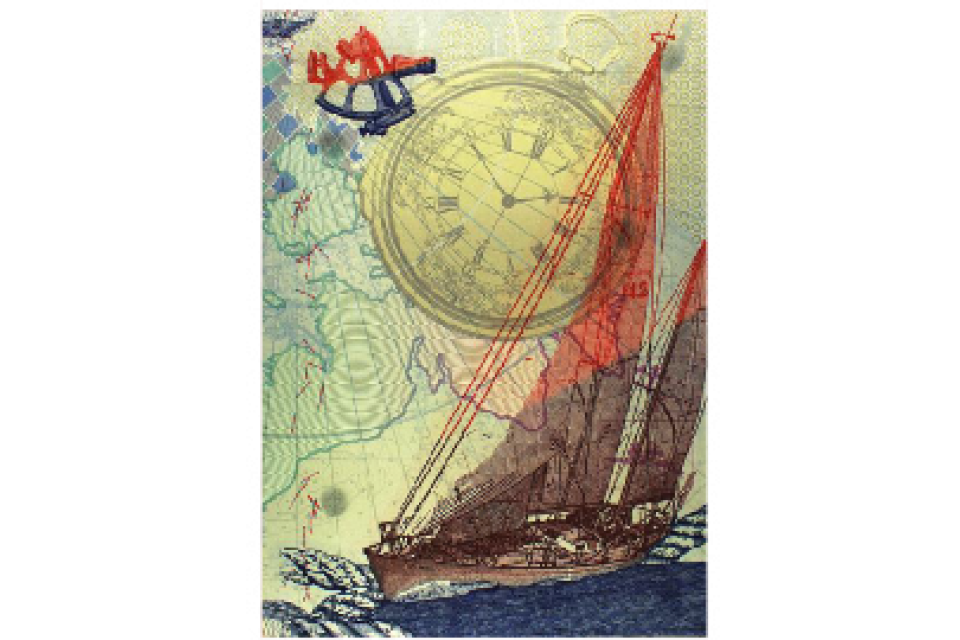
Rear end page (normal light)

Biodata and Official Observations pages (normal light)

Biodata and Official Observations pages (UV light)
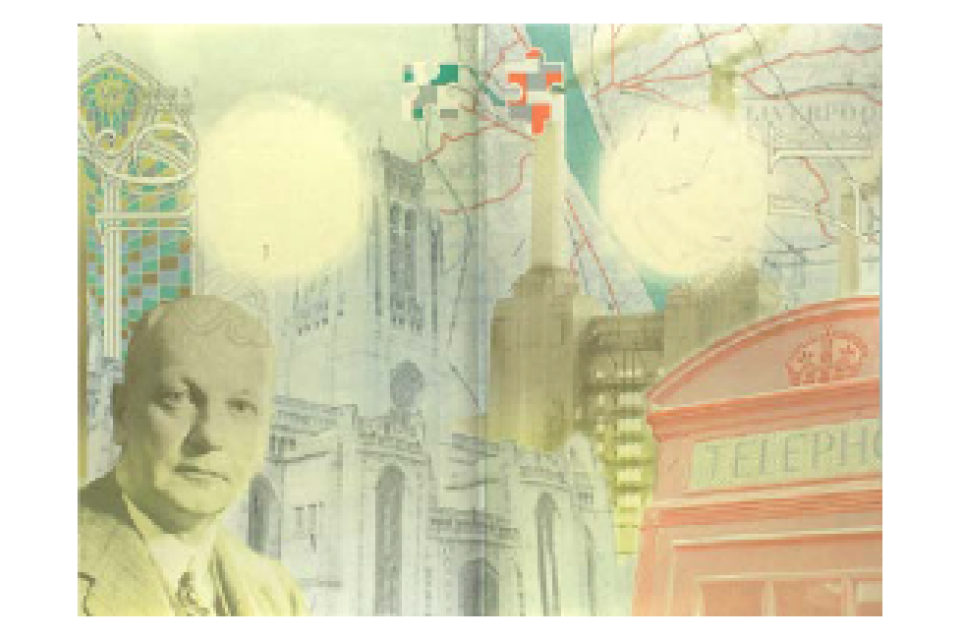
Typical visa page demonstrating a cross-page design (normal light)

Typical visa page demonstrating a cross-page design (UV light)
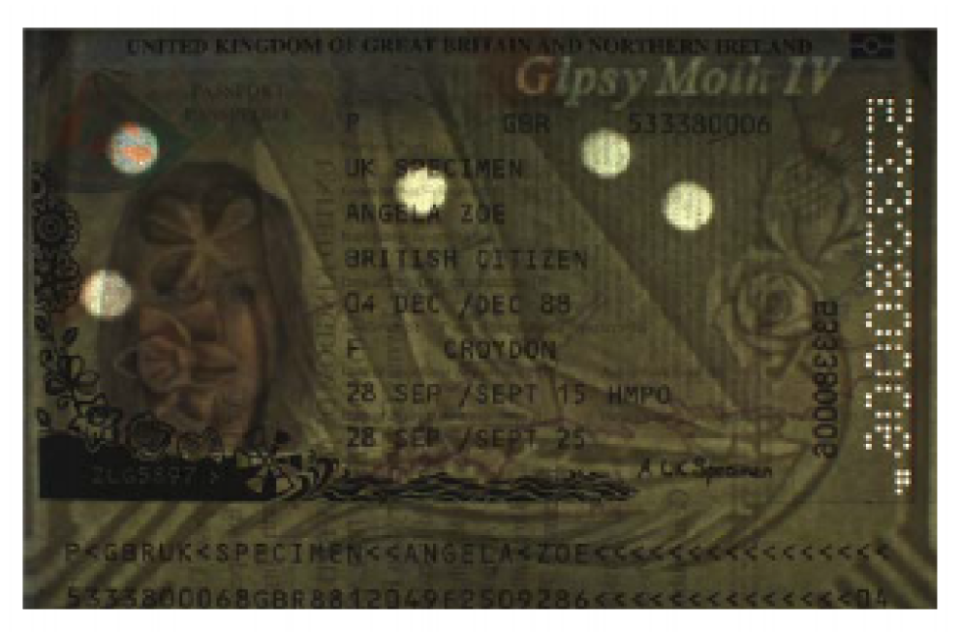
Biodata page (watermark)

Visa page (watermark)
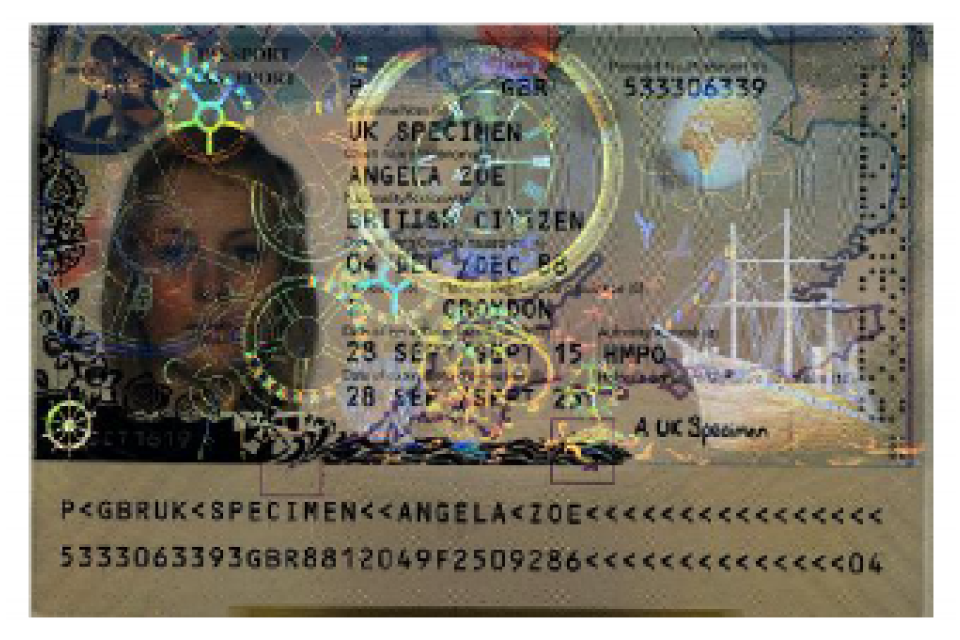
Holographic elements of thin film patch
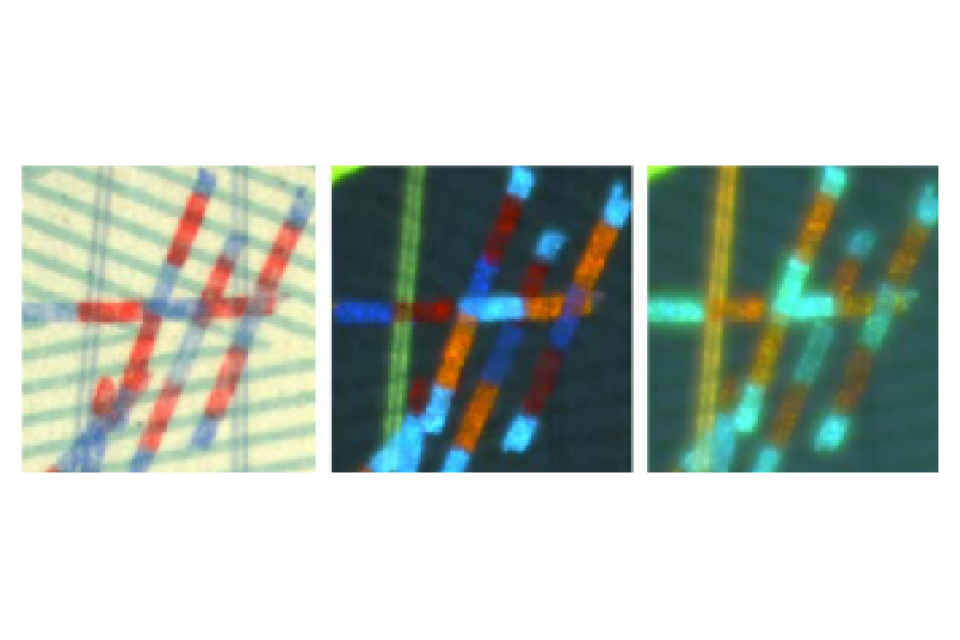
Candy striped fibres (Visible, UV long wavelength, UV short wavelength respectively)
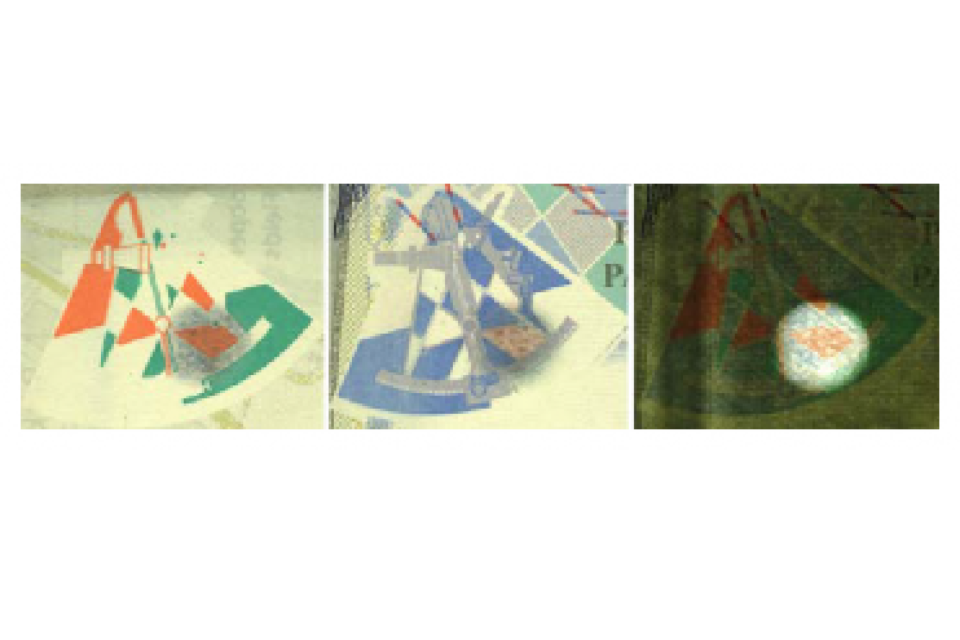
See-through feature (Page 1/Biodata page)

See-through feature (Visa pages)

Variable hole shaped laser perforated numbering/Stitching thread (normal light)/Stitching thread (UV light) respectively
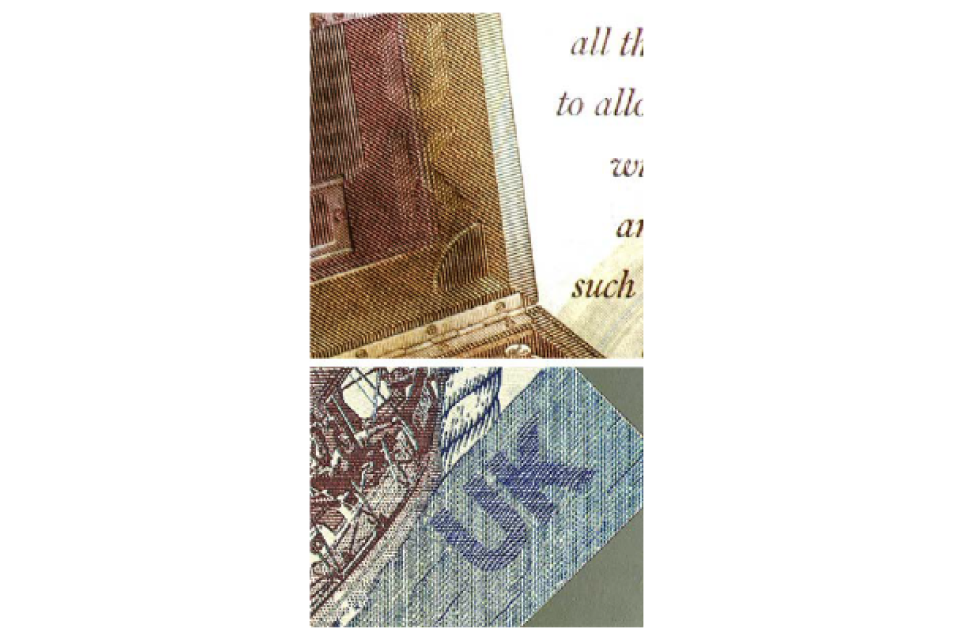
Latent images: End pages
Passports introduced in 2020
The new UK series C e-Passport will be introduced through a phased implementation from early 2020. During this transition period some customers will receive the series C e-Passport, whilst others will receive the e-Passport that was introduced in 2015. All issued UK passports will continue to be valid until their stated date of expiry.
This passport comprises a dark blue coloured passport cover, and a Biographical Data page that is constructed from polycarbonate. All other pages within the passport are made of paper.
Unless the passport holder is unable to physically sign their passport due to age or disability, holders of the series C e-Passport must provide a physical, wet ink signature on page 3 (the Official Observations page) in the area that is reserved for the holder’s signature.
Key information
Validity
Adult passports will be valid for a maximum period of 10 years.
Child passports will be valid for a maximum period of five years.
Size
• Approximately 125 x 88mm.
Number of pages
• Standard e-Passports contain 34 pages.
• Frequent traveller e-Passports contain 54 pages.
Personalisation
• A combination of laser engraving and inkjet printing technologies are used.
• Digital images of the passport holder are laser engraved onto the Title and Biographical Data pages and also printed in colour on page 3.
• A further digital image of the passport holder is embedded into the electronic chip.
Numbering
9 numerical digits are:
• Printed on the inner front cover page.
• Engraved into the Title page.
• Laser perforated from the Title page through to the rear cover.
Observations
• The inner front cover page contains characters which become visible when observed using the decoding lens that is integrated into the Biographical Data page.
• Personalised data contained on the Title and Biographical Data pages is protected with animatic embossed designs that are integrated into the surface of the polycarbonate.
• The passport holder’s image on the Title page is engraved using a reduced density of grey when compared with the holder’s image that is engraved into the Biographical Data page.
• A full colour graphic of the four floral motifs which represent the UK is printed with invisible ink on
the Title page.
• A small window on the Biographical Data page displays interchanging images of the passport holder’s engraved image and date of birth.
• An oval shaped hologram safeguards the passport holder’s digital image that is engraved into the Biographical Data page.
• Official Observations about the passport holder are printed on page 3.
• The inkjet printed image of the passport holder on page 3 contains invisible data which becomes visible when observed using the decoding lens that is integrated into the Biographical Data page.
• Visa page pairs feature a closely registered cross page design that is continuous across both pages.
• A security thread (as seen in bank notes) is embedded into each passport visa page.
• The letters ‘UK’ can be seen on visa page edges when the visa pages are fanned.
Note
There is one polycarbonate page located at the start of the passport. On the front of this page is the Title page and on the back is the Biographical Data page. The electronic chip is embedded within this page.

Passport cover
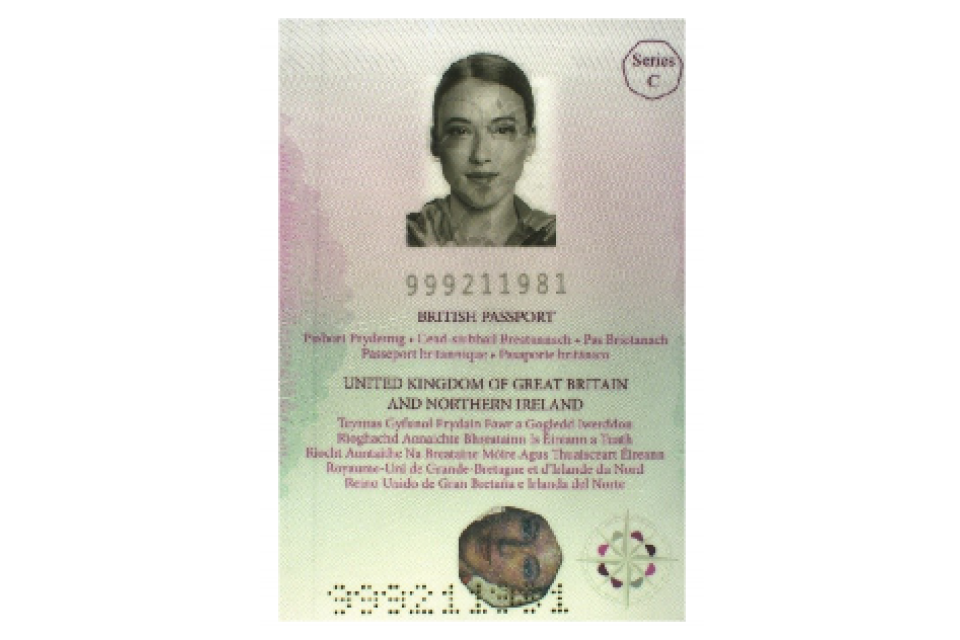
Title page

Title page (UV)
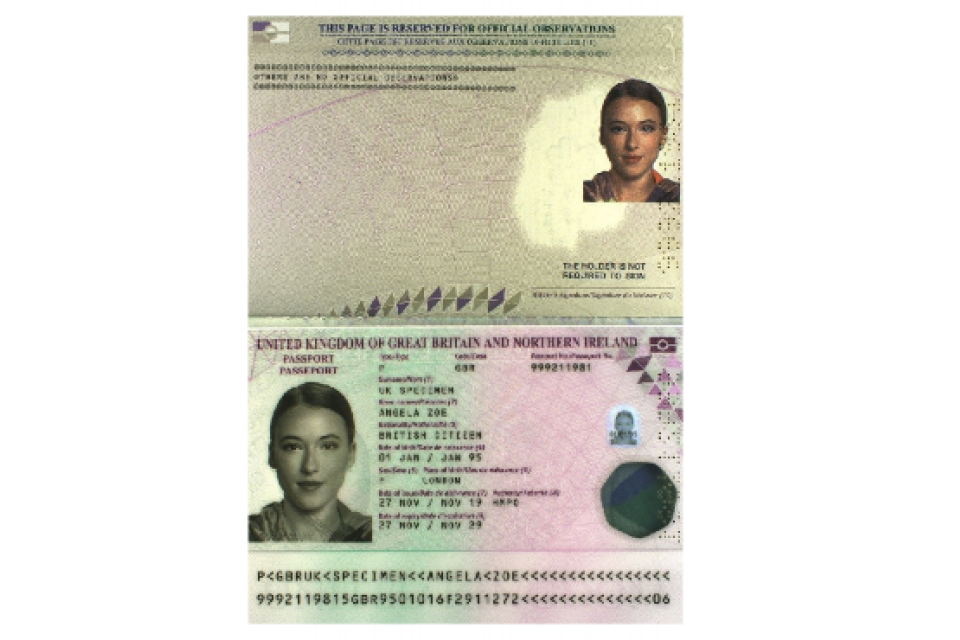
Biographical Data and Official Observations pages
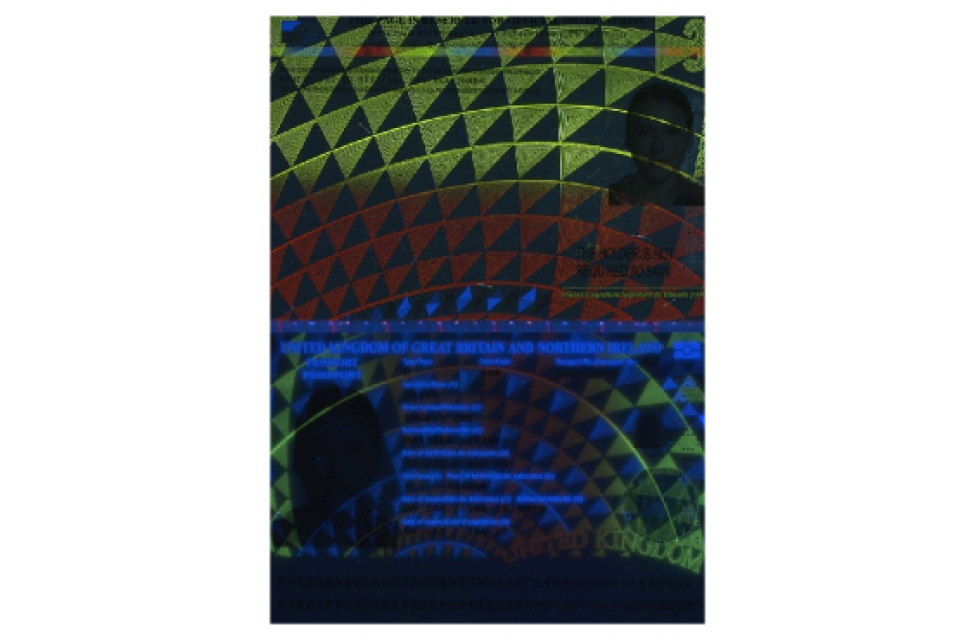
Biographical Data and Official Observations pages (UV)
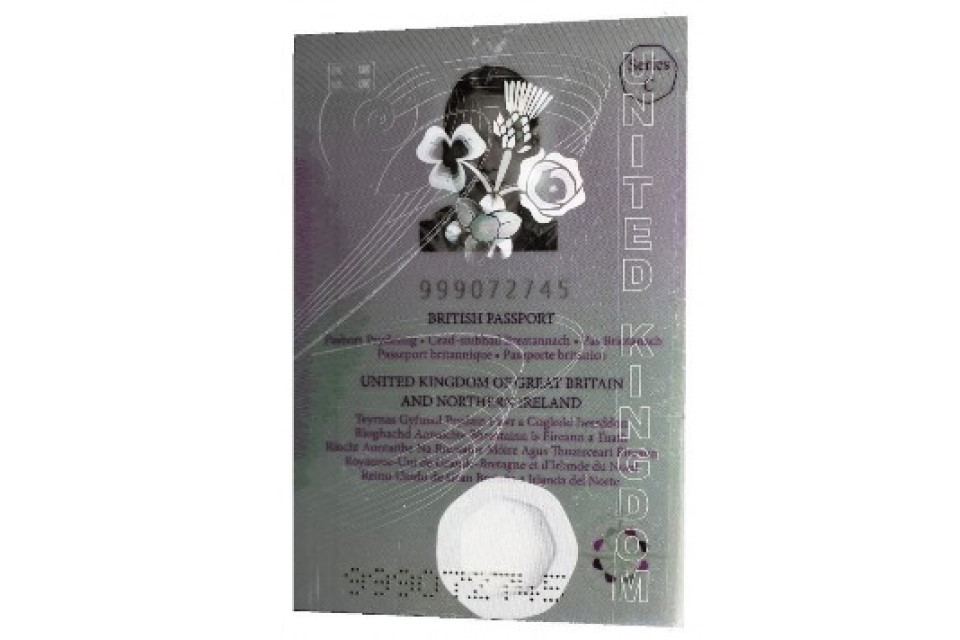
Animatic embossing: Title page
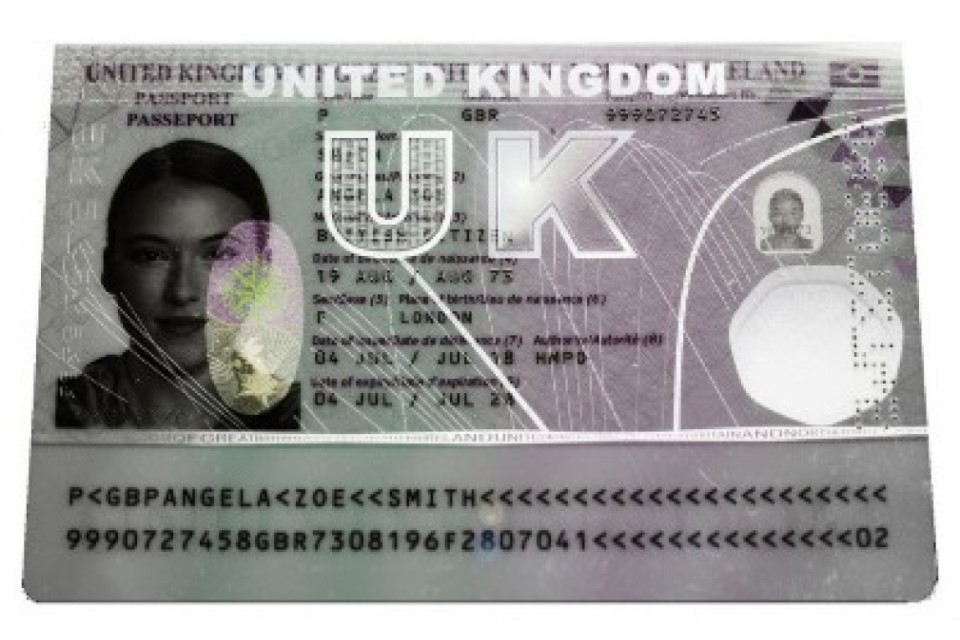
Animatic embossing: Biographical Data page
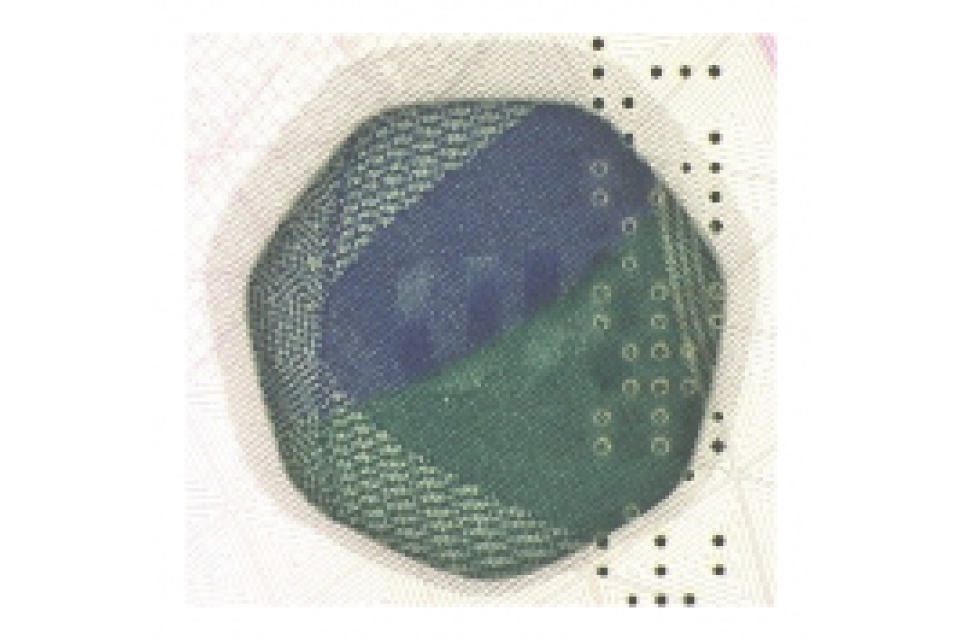
Decoding lens: Inner front cover page
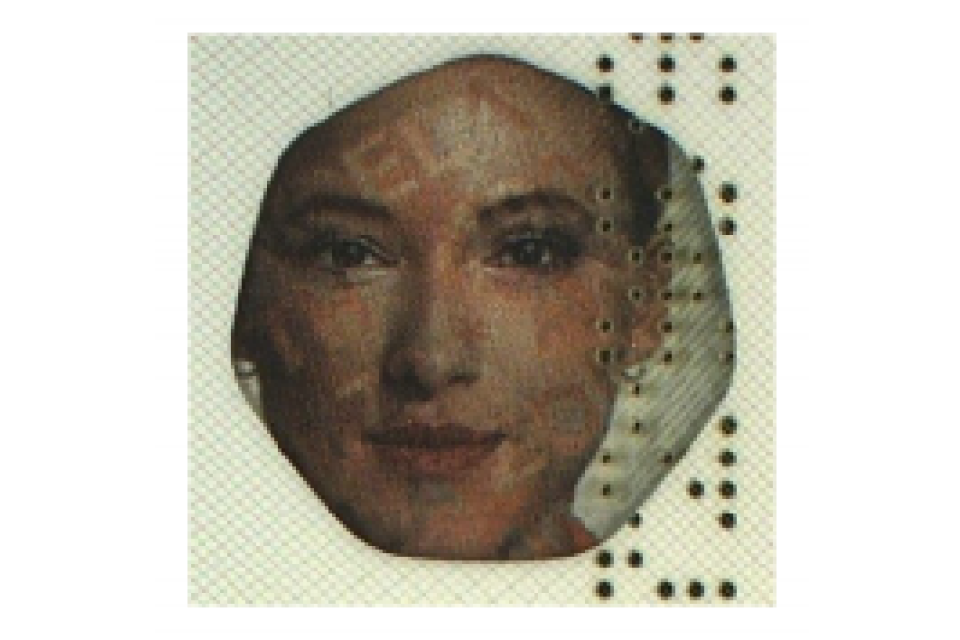
Decoding lens: Official Observations page
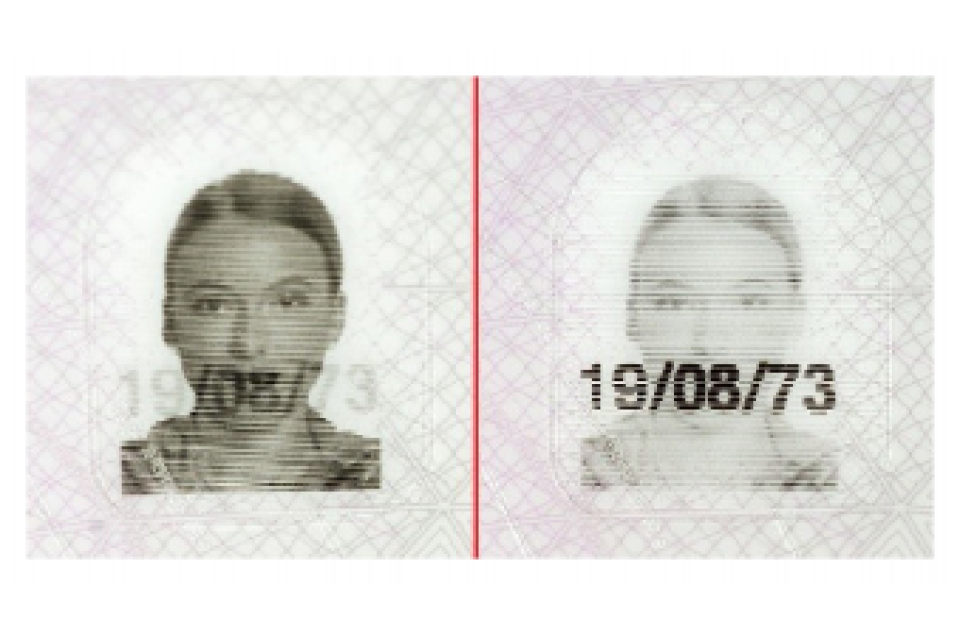
Interchanging images: Biographical Data page
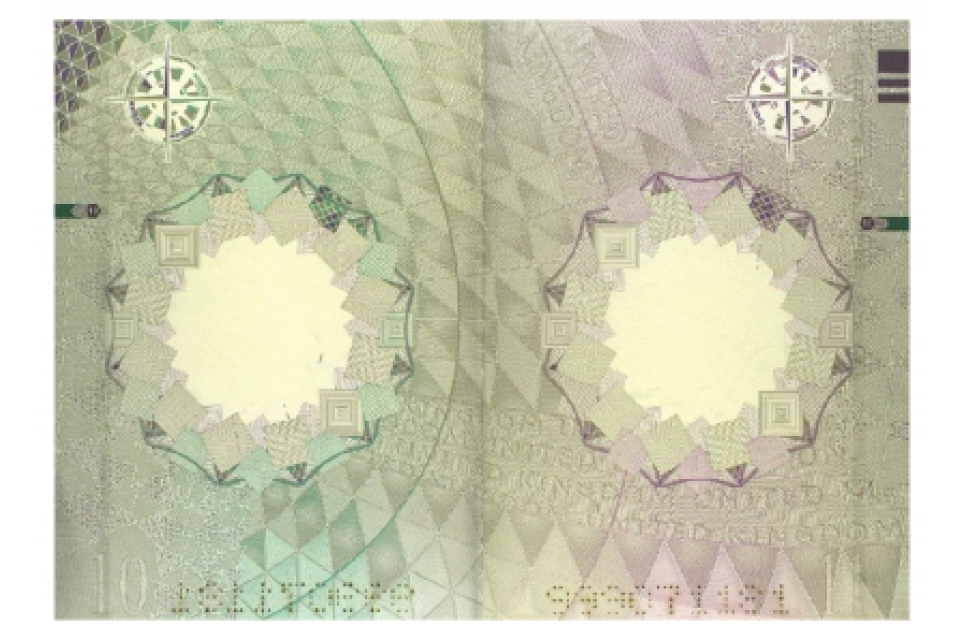
Visa page design
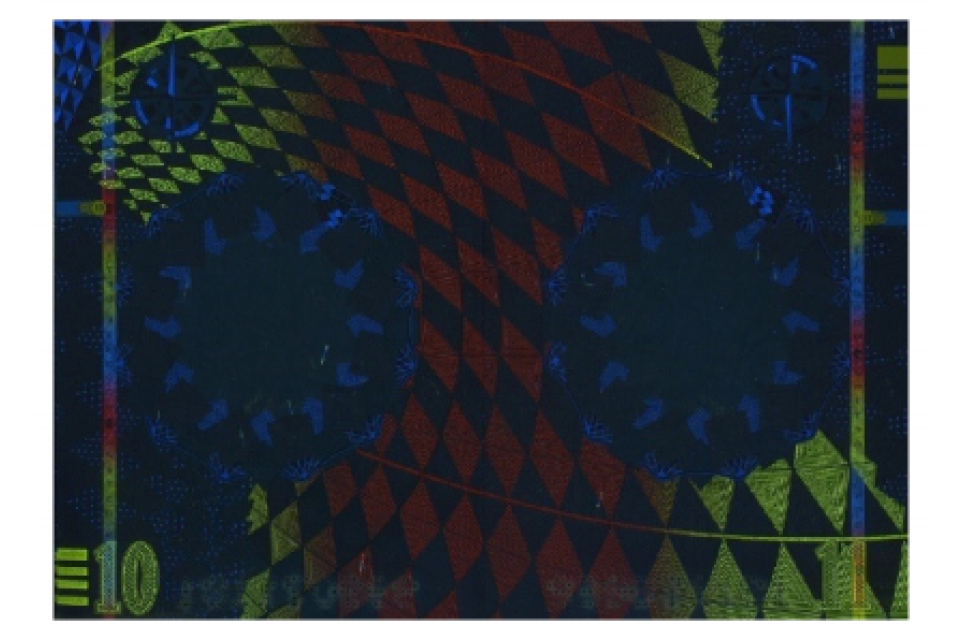
Visa page design (UV)
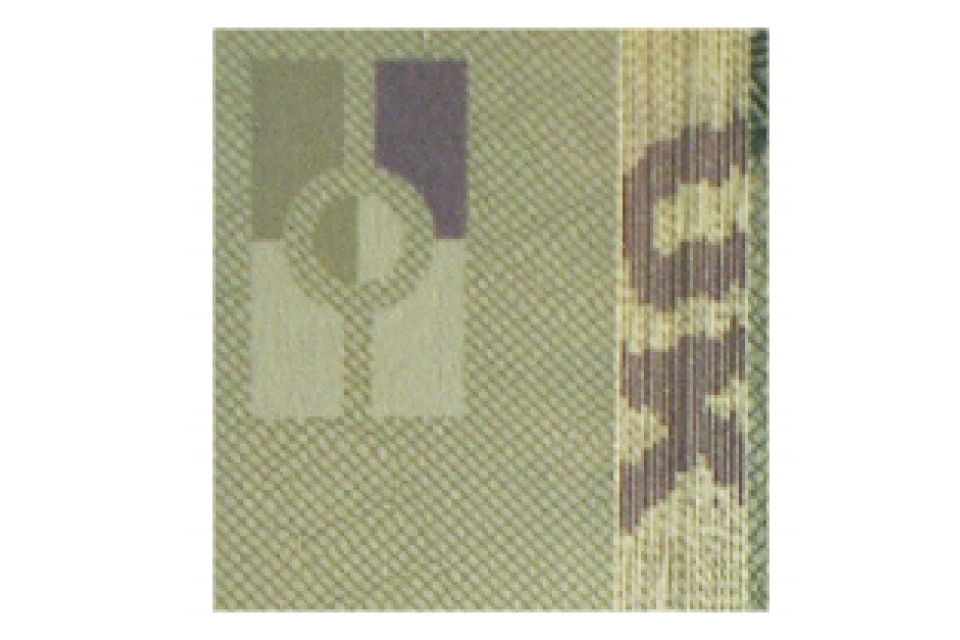
Visa page fanning feature
Passports introduced in 2025
HM Passport Office will begin a phased introduction of the series D e-Passport from December 2025.
During this transitional period, some applicants will receive the series D e-Passport, while others will continue to receive the series C e-Passport.
All UK passports, regardless of series, will remain valid until their stated date of expiry. Similar to the series C e-Passport, series D e-Passports feature a dark blue cover and a Biographical Data page constructed from durable plastic. The remaining pages of the passport are composed of paper.
Unless exempt due to age or disability, all holders of the Series D e-Passport are required to provide a physical (wet ink) signature on page 3 (the Official Observations page), in the designated signature area.
Key information
Validity
The series D e-Passport is valid for a maximum period of up to 10 years. For applicants under the age of 16, passports will be issued with a validity period of five years.
Size
- Approximately 125 x 88mm.
Number of pages
- Standard e-Passports contain 34 pages.
- Frequently Traveller e-Passports comprise 54 pages.
Personalisation
- Combination of laser engraving and full-colour printing technologies.
- Portrait images are laser-engraved on both the Title Page and the Biographical Data Page of the passport. In addition, a colour digital image is printed on the Official Observations page.
- A digital representation of the bearer’s portrait is securely encoded within the passport’s electronic chip.
Numbering
- 9 numerical digits printed on the inner front cover.
- Engraved into the passport’s Title page.
- Laser perforated from the passport Title page through to the rear cover.
- Personalised by an engraving laser on the passport’s Biographical Data page. Observations
- The Title page of the passport features irregularly shaped voids that visibly demonstrate the polycarbonate layering used in its construction.
- Embossing techniques are used on the passport’s Title page to create animatic effects that enhance the security of the bearer’s image and other key elements.
- The passport’s Title page also features high-definition floral motifs, printed using true-colour ultraviolet inks.
- An irregularly shaped hologram protects the bearer’s primary printed image on the Biographical data page.
- When the biographical data page is tilted, alternating images of the bearer’s photo and date of birth appear within a transparent window.
- On the Biographical data page, the bearer’s date of birth and passport number are printed with enhanced boldness and tactility, making them more prominent than other variable data.
- Official observations about the passport holder are printed on page 3.
- The full colour portrait on the Official Observations page contains concealed data that becomes visible when viewed through the decoding lens integrated into the Biographical data page.
- Ultraviolet printing is applied to protect the full colour image of the passport bearer on the Official Observations page of the passport.
- The visa pages of the passport feature four distinct designs that are repeated throughout the passport.
Note
- The front cover of the passport features the Royal Arms of His Majesty King Charles III, embossed in gold foil.
- The Title page is located on page 1 (plastic page) of the passport.
- The Biographical Data page is on page 2 of the passport.

Passport cover

Title page

Title page: ultraviolet

Biographical and observations pages: ultraviolet printing

Biographical data and observation pages

Irregular shaped voids: title page

Embossing techniques: title page

Ultraviolet floral motifs: title page

Hologram: biographical data page

Transparent window: biographical data page

Tactile variable data: biographical data page

Decoding lens: official observations page

Ultraviolet image protection: official observations page

Passport visa page

Passport visa page: ultraviolet printing
